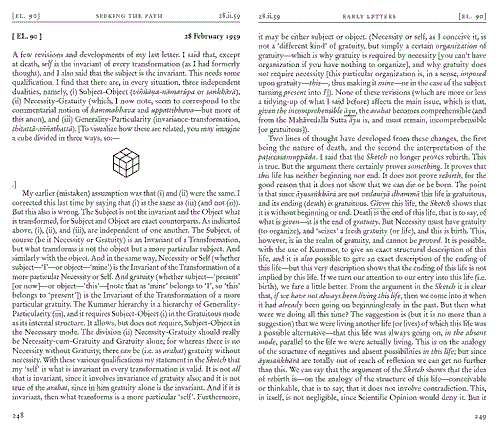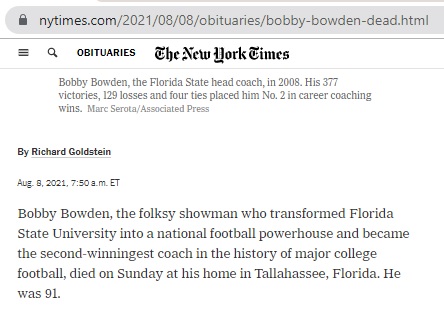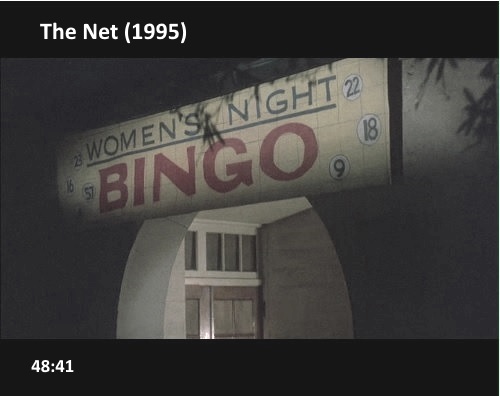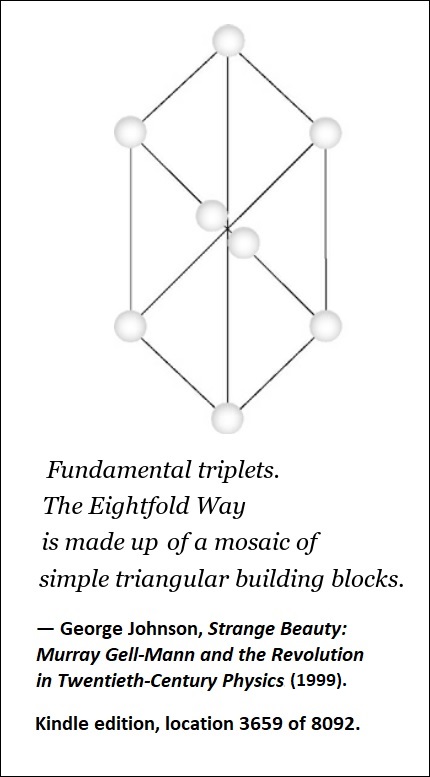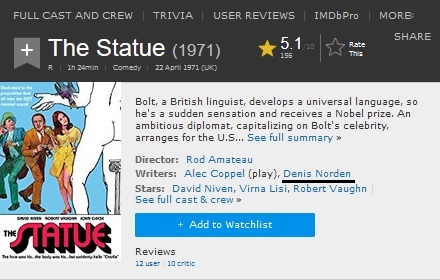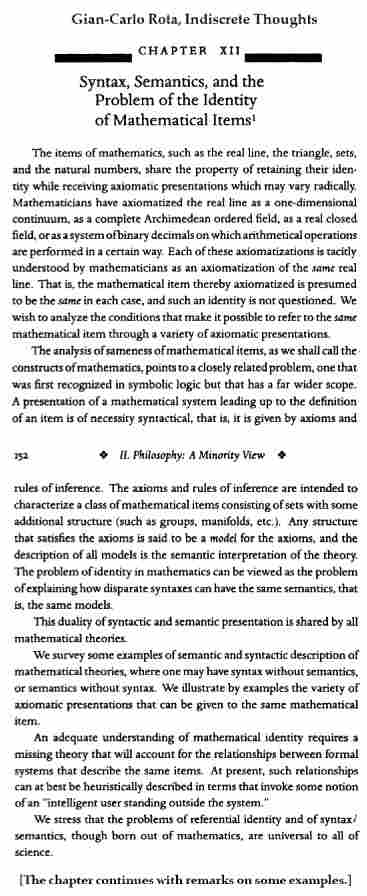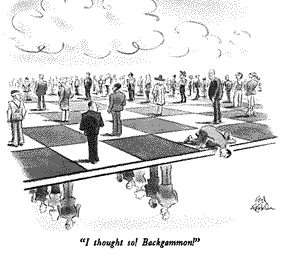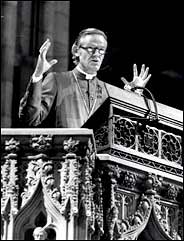Thursday, January 29, 2015
Die Cast
Saturday, May 25, 2024
The Faustus Square:* Casting the Die
* See also The Faustus Square in the May 18 post "The Godfather's Art."
Tuesday, March 15, 2011
Wednesday, January 5, 2022
The Casting Couch and the Killer Clown … Exclusive!
Wednesday, May 26, 2021
The Senator from Central Casting
From the above obituary —
"A debonair Virginian, Mr. Warner was sometimes called
the senator from central casting; his ramrod military posture,
distinguished gray hair and occasionally overblown
speaking style fit the Hollywood model." — Carl Hulse
Related material — The previous post and . . .

Sunday, January 17, 2021
The Miscast Spell
See Spectre and Spectral in this journal.
Details — “California Health Care Facility inmate Phillip Spector, 80,
was pronounced deceased of natural causes at 6:35 p.m. [California time]
on Saturday, January 16, 2021, at an outside hospital. His official cause of
death will be determined by the medical examiner in the San Joaquin
County Sheriff’s Office.”
— California Department of Corrections and Rehabilitation
Sunday, February 19, 2017
Cast
"La morte è avvenuta alle 22.30 di ieri sera nella sua abitazione."
— http://www.repubblica.it/cultura/2016/02/20/news/
morto_lo_scrittore_umberto_eco-133816061/
See also the previous post, "Radical."
Thursday, July 2, 2015
Saturday, August 24, 2013
Cast (continued)
The death yesterday of British cinematographer
Gilbert Taylor suggests an image from last evening's
Log24 search Point Omega —
 .
.
The die in the above image (shown here Dec. 28, 2012)
displays the numbers 3-6-5 in counterclockwise order.
A similar die in an earlier post served as a metaphor for
a time-jump to 365 days in the past.
For some religious remarks by Umberto Eco that may
serve as a small memorial to Taylor, see this journal
a year before the day he died— August 23, 2012.
Thursday, December 27, 2012
Cast
Note that the visible faces of the die, in counter -clockwise
order, are 3 6 5. See also this journal 365 days ago and,
since 2012 is a leap year, also today's date last year.
Saturday, August 20, 2011
Castle Rock
Happy birthday to Amy Adams
(actress from Castle Rock, Colorado)
"The metaphor for metamorphosis…" —Endgame
Related material:
"The idea that reality consists of multiple 'levels,' each mirroring all others in some fashion, is a diagnostic feature of premodern cosmologies in general…."
— Scholarly paper on "Correlative Cosmologies"
"How many layers are there to human thought? Sometimes in art, just as in people’s conversations, we’re aware of only one at a time. On other occasions, though, we realize just how many layers can be in simultaneous action, and we’re given a sense of both revelation and mystery. When a choreographer responds to music— when one artist reacts in detail to another— the sensation of multilayering can affect us as an insight not just into dance but into the regions of the mind.
The triple bill by the Mark Morris Dance Group at the Rose Theater, presented on Thursday night as part of the Mostly Mozart Festival, moves from simple to complex, and from plain entertainment to an astonishingly beautiful and intricate demonstration of genius….
'Socrates' (2010), which closed the program, is a calm and objective work that has no special dance excitement and whips up no vehement audience reaction. Its beauty, however, is extraordinary. It’s possible to trace in it terms of arithmetic, geometry, dualism, epistemology and ontology, and it acts as a demonstration of art and as a reflection of life, philosophy and death."
— Alastair Macaulay in today's New York Times
SOCRATES: Let us turn off the road a little….
— Libretto for Mark Morris's 'Socrates'
See also Amy Adams's new film "On the Road"
in a story from Aug. 5, 2010 as well as a different story,
Eightgate, from that same date:

The above reference to "metamorphosis" may be seen,
if one likes, as a reference to the group of all projectivities
and correlations in the finite projective space PG(3,2)—
a group isomorphic to the 40,320 transformations of S8
acting on the above eight-part figure.
See also The Moore Correspondence from last year
on today's date, August 20.
For some background, see a book by Peter J. Cameron,
who has figured in several recent Log24 posts—

"At the still point, there the dance is."
— Four Quartets
Thursday, February 1, 2024
Kiss of the Spider Variations
In memory of a Broadway star who reportedly died on Jan. 30 . . .

A Jan. 29 New Yorker story, "Life with Spider," suggests
a look at the author's earlier novel The Variations and,
after a synchronology check, a Log24 flashback —

Thursday, September 7, 2023
|
See also Fritz Leiber's rather different Spider Woman in this journal.
Saturday, September 30, 2023
Tuesday, May 30, 2023
The Tour
In memory of a co-founder of Hollywood's "Magic Castle"
who reportedly died at 92 on Sunday . . .
From posts that were tagged "Blake Tour" on Sunday —
Wednesday, February 15, 2023
“Buy on Proof”
The above title is a commercial slogan from Westinghouse Studio One —
in particular, from its "June Moon" broadcast on June 22, 1949.
The date August 4, 2011, from the previous post suggests a review . . .
Tuesday, November 8, 2022
Trophy

A more cheerful moment, from June 19, 2019:
Crystal Ocean wins the Prince of Wales trophy —

Related entertainment from this journal on June 19, 2019 —
"Our die was cast."
Sunday, August 8, 2021
Requiem for a Showman
"Bowden applied what he viewed as the lessons of the battlefield
to the football field. While bedridden with rheumatic fever at age 13,
he had listened to radio broadcasts telling of World War II battles,
and he later studied the campaigns of Patton, MacArthur and
Germany’s Erwin Rommel.
'They all demonstrate discipline,' Bowden once said, 'and that you
need reserves so that if you’re getting annihilated on one front, you
can attack somewhere else.' ” — Richard Goldstein
Amen.
See as well "Geometry Battlefield" in this morning's previous post.
Saturday, August 15, 2020
Lives of the Painters: Dutch Boy
“Harry decides his chief peacetime duty is to use his
gift for gab to further his ‘overriding purpose,’ namely:
‘By recalling the past and freezing the present he could
open the gates of time and through them see all
allegedly sequential things as a single masterwork
with neither boundaries nor divisions.’ Once he opens
these gates, Harry will flood his audience with his
redemptive epiphanic impression that ‘the world was
saturated with love.’ ”
— Liesl Schillinger, review of Mark Helprin’s novel
In Sunlight and in Shadow in The New York Times ,
Oct. 5, 2012

Tuesday, July 14, 2020
The Sextet Enigma
In memory of . . .
“Helene Lovie Aldwinckle,
codebreaker, broadcaster and gallerist,
born 26 October 1920; died 24 April 2020″ —
Other posts now also tagged The Cologne Sextet.
Tuesday, June 9, 2020
Tune for a Dark Corner
"Like the castle in its corner
In a medieval game"
— Steely Dan, Dirty Work, 1972
Saturday, April 25, 2020
The Grandfather Clock
“Well, I’ve helped to wind up the clock —
I might as well hear it strike!”
— Said to be a quotation from the grandfather
of a “pirate radio” founder who reportedly died
at 79 on April 20.
See as well this journal on the night of April 20 —
Wheel Turnin’ ’Round and ’Round —
and a search for “Wheel of Time.”
Tuesday, November 19, 2019
Game
Another game featured in the above film —
“In Wolfenstein 3D , the player assumes the role of an American
soldier of Polish descent… attempting to escape from the Nazi
stronghold of Castle Wolfenstein.” — Wikipedia
… See also this journal’s Wolfenstein.
Wednesday, June 19, 2019
The Panhandle Project
"When they all finally reach their destination —
a deserted field in the Florida Panhandle…."
" When asked about the film's similarities to the 2015 Disney movie
Tomorrowland , which also posits a futuristic world that exists in an
alternative dimension, Nichols sighed. 'I was a little bummed, I guess,'
he said of when he first learned about the project. . . . 'Our die was cast.
Sometimes this kind of collective unconscious that we're all dabbling in,
sometimes you're not the first one out of the gate.' "
Saturday, June 1, 2019
Crystals for Dabblers
The title was suggested by the "Crystal Cult" installations
of Oslo artist Josefine Lyche and by a post of May 30 —
|
Thursday, May 30, 2019 Filed under: General — m759 @ 8:02 PM Edit This Jeff Nichols, director of Midnight Special (2016) —
"When asked about the film's similarities to See also Jung's four-diamond figure and the previous post. |
Writers of fiction are, of course, also dabblers in the collective unconscious.
For instance . . .
A 1971 British paperback edition of The Dreaming Jewels,
a story by Theodore Sturgeon (first version published in 1950):

The above book cover, together with the Death Valley location
Zabriskie Point, suggests . . .
Those less enchanted by the collective unconscious may prefer a
different weblog's remarks on the same date as the above Borax post . . .
Thursday, May 30, 2019
Dabbling
Jeff Nichols, director of Midnight Special (2016) —
"When asked about the film's similarities to the 2015 Disney
movie Tomorrowland , which also posits a futuristic world
that exists in an alternative dimension, Nichols sighed.
'I was a little bummed, I guess,' he said of when he first
learned about the project. . . . 'Our die was cast.
Sometimes this kind of collective unconscious that
we're all dabbling in, sometimes you're not the first one
out of the gate.' "
See also Jung's four-diamond figure and the previous post.
Sunday, May 26, 2019
Wednesday, May 15, 2019
Hunger Games
Two items from November 24, 2015 —
|
Tuesday, November 24, 2015 Filed under: General — m759 @ 11:11 PM
In memory of economic historian Douglass C. North, “We needed new tools, but they simply did not exist.” Related reading and viewing — Beattyville, Kentucky and Log24 post About the People. |
Related material —

David Bowie and Catherine Deneuve star in "The Hunger" (1983).
Vampira and Loki at Cannes
Sunday, May 12, 2019
The Collective Unconscious in a Cartoon Graveyard
Tobey Maguire and Kirsten Dunst
in "Spider-Man 2" (2004) —
Spoilers for another Kirsten Dunst film,
"Midnight Special" (2016) —
"When they all finally reach their destination —
a deserted field in the Florida Panhandle…."
" When asked about the film's similarities to the 2015 Disney movie
Tomorrowland , which also posits a futuristic world that exists in an
alternative dimension, Nichols sighed. 'I was a little bummed, I guess,'
he said of when he first learned about the project. . . . 'Our die was cast.
Sometimes this kind of collective unconscious that we're all dabbling in,
sometimes you're not the first one out of the gate.' "
From another obituary for
the "Spider-Man" screenwriter —
“When I die,” he liked to say, “I’m going to have written
on my tombstone, ‘Finally, a plot!’”
Monday, November 12, 2018
Half Crazy
Douglas Rain, the voice of HAL in Kubrick's 2001 , reportedly
died at 90 on Sunday, Nov. 11, 2018. A piece from the Sunday,
April 1, 2018, print edition of The New York Times recalls that . . .
|
When HAL says, “I know I’ve made some very poor decisions recently, but I can give you my complete assurance that my work will be back to normal,” Mr. Rain somehow manages to sound both sincere and not reassuring. And his delivery of the line “I think you know what the problem is just as well as I do” has the sarcastic drip of a drawing-room melodrama and also carries the disinterested vibe of a polite sociopath. Kubrick had Mr. Rain sing the 1892 love song “Daisy Bell” (“I’m half crazy, all for the love of you”) almost 50 times, in uneven tempos, in monotone, at different pitches and even just by humming it. In the end, he used the very first take. Sung as HAL’s brain is being disconnected, it’s from his early programming days, his computer childhood. It brings to an end the most affecting scene in the entire film.
— Gerry Flahive in the online New York Times , "A version of this article appears in print on , on Page AR13 of the New York edition with the headline: HAL 9000 Wasn’t Always So Eerily Calm." |
This journal on the above online date, March 30, 2018 —
"Program or be programmed."
— A saying by Douglas Rushkoff
See as well the following link from this journal
on Armistice Day, the reported date of Mr. Rain's death —
Wednesday, September 19, 2018
In Memoriam:
Denis Mostyn Norden, writer, broadcaster and television presenter,
born 6 February 1922; died 19 September 2018.
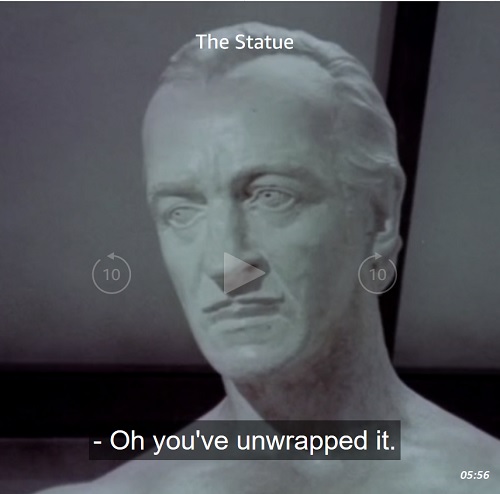
For Abraham Warburg —
"Que cantaba el Rey David."
Wednesday, November 30, 2016
In Nuce
|
Excerpts from James C. Nohrnberg, "The Master of the Myth of Literature: An Interpenetrative Ogdoad for Northrop Frye," Comparative Literature Vol. 53, No. 1 (Winter, 2001), pp. 58-82
From page 58 — * P. 22 of Rereading Frye: The Published and Unpublished Works , ed. David Boyd and Imre Salusinszky, Frye Studies [series] (Toronto: University of Toronto Press, 1998). [Abbreviated as RF .]
From page 62 —
From page 63 —
From page 69 —
From page 71 —
From page 77 — |
Friday, May 13, 2016
For the Late Mark Lane
Sixties conspiracy theorist Mark Lane reportedly
died at 89 on Tuesday night.
From the previous post, But Seriously . . . —
"Today, we are excited to share the fruits of our research
with the broader community . . . ."

Monday, May 9, 2016
Requiem for an Authority Figure
Today's online New York Times describes an authority
figure who reportedly died on Sunday (May 8, 2016) —
"With his preternaturally mature, intelligent but
(by Hollywood standards) unremarkable looks,
he was cast almost from the beginning as an
authority figure — a father or a teacher, a doctor
or a scientist, a mayor or a judge."
This journal on Sunday —
Wednesday, March 23, 2016
Requiem for an Actress
The New York Times this evening on the late Rita Gam:
"After generally being typecast in supporting roles
in two dozen films for what Life described as
'her sultry face and insinuating voice,' she recalled
in 1992, 'I looked into the black pit at 40 and
wondered, what do I do for an encore?' "
See also Sidney Lumet in this journal as well as
"Some cartoon graveyards are better than others."
Monday, December 28, 2015
Mirrors, Mirrors, on the Wall
The previous post quoted Holland Cotter's description of
the late Ellsworth Kelly as one who might have admired
"the anonymous role of the Romanesque church artist."
Work of a less anonymous sort was illustrated today by both
The New York Times and The Washington Post —
The Post 's remarks are of particular interest:
|
Philip Kennicott in The Washington Post , Dec. 28, 2015, “Sculpture for a Large Wall” consisted of 104 anodized aluminum panels, colored red, blue, yellow and black, and laid out on four long rows measuring 65 feet. Each panel seemed different from the next, subtle variations on the parallelogram, and yet together they also suggested a kind of language, or code, as if their shapes, colors and repeating patterns spelled out a basic computer language, or proto-digital message. The space in between the panels, and the shadows they cast on the wall, were also part of the effect, creating a contrast between the material substance of the art, and the cascading visual and mental ideas it conveyed. The piece was playful, and serious; present and absent; material and imaginary; visually bold and intellectually diaphanous. Often, with Kelly, you felt as if he offered up some ideal slice of the world, decontextualized almost to the point of absurdity. A single arc sliced out of a circle; a single perfect rectangle; one bold juxtaposition of color or shape. But when he allowed his work to encompass more complexity, to indulge a rhetoric of repetition, rhythmic contrasts, and multiple self-replicating ideas, it began to feel like language, or narrative. And this was always his best mode. |
Compare and contrast a 2010 work by Josefine Lyche —
Lyche's mirrors-on-the-wall installation is titled
"The 2×2 Case (Diamond Theorem)."
It is based on a smaller illustration of my own.
These variations also, as Kennicott said of Kelly's,
"suggested a kind of language, or code."
This may well be the source of their appeal for Lyche.
For me, however, such suggestiveness is irrelevant to the
significance of the variations in a larger purely geometric
context.
This context is of course quite inaccessible to most art
critics. Steve Martin, however, has a phrase that applies
to both Kelly's and Lyche's installations: "wall power."
See a post of Dec. 15, 2010.
Sunday, September 20, 2015
Misgiving
"Charles Kenneth Williams was born on Nov. 4, 1936,
in Newark. His father, Paul, sold office machines,
and, as he prospered, moved with his wife, the former
Dossie Kasdin, and his two sons to suburban South Orange.
Mr. Williams’s conflicted relationship with his parents
takes up much of his 2000 memoir, Misgivings: My Mother,
My Father, Myself . " — NY Times obituary this evening
Near the Haunted Castle
A poem by C. K. Williams
"This is a story. You don't have to think about it,
it's make-believe. / It's like a lie, maybe not quite a lie
but I don't want you to worry about it. . . . ."
For a more interesting cinematic haunting, see the new film "Pay the Ghost."
Sunday, May 10, 2015
Mother’s Day for Bill Murray

The late Elizabeth Wilson as
the mother of Billl Murray's FDR
in "Hyde Park on Hudson."
Wilson reportedly died at 94 on Saturday, May 9, 2015.
Related material: This journal on that date, and
the following —
Monday, August 4, 2014
Bunch vs. Bunch
“This is a divorce case that was before us on an earlier occasion.”
Wild:
From the director of The Wild Bunch —
Brady:
From The New York Times —
Sunday, August 3, 2014
Unplatonic Dialogue
Dialogue from “The Osterman Weekend”—
01:57:22 “Why did he make us try to believe Omega existed?”
01:57:25 ….
01:57:26 “The existence of Omega has not been disproved.
01:57:28 Don’t you understand that?
01:57:31 Omega is as real as we need it to be.”

See also Omega elsewhere in this journal.
Update of 9:15 PM ET —
Thursday, June 26, 2014
Study This Example, Part II
(Continued from 10:09 AM today)
The quotation below is from a webpage on media magnate
Walter Annenberg.
Annenberg Hall at Harvard, originally constructed to honor
the Civil War dead, was renamed in 1996 for his son Roger,
Harvard Class of ’62.
www.broadcastpioneers.com/
walterannenberg.html —
“It was said that Roger was ‘moody and sullen’
spending large parts of his time reading poetry
and playing classical music piano. It had been
reported that Roger attempted suicide at the
age of eleven by slitting his wrists. He recovered
and was graduated Magna Cum Laude from
Episcopal Academy in our area. For awhile,
Roger attended Harvard, but he was removed
from the school’s rolls after Roger stopped doing
his school work and spent almost all his time
reading poetry in his room. He then was sent to
an exclusive and expensive treatment center
in Bucks County, Pennsylvania. At that facility,
Roger became more remote. It was said that he
often didn’t recognize or acknowledge his father.
On August 7, 1962, Roger Annenberg died from
an overdose of sleeping pills.”
A more appropriate Annenberg memorial, an article
in The Atlantic magazine on June 25, notes that…
“Among those who ended up losing their battles
with mental illness through suicide are
Virginia Woolf, Ernest Hemingway, Vincent van Gogh,
John Berryman, Hart Crane, Mark Rothko, Diane Arbus,
Anne Sexton, and Arshile Gorky.”
Tuesday, January 7, 2014
See More Glass
The first story of "The Snow Queen, in Seven Stories"
by Hans Christian Andersen (1845) (see yesterday morning)—
|
Story the First, You must attend to the commencement of this story, for when we get to the end we shall know more than we do now about a very wicked hobgoblin; he was one of the very worst, for he was a real demon. One day, when he was in a merry mood, he made a looking-glass which had the power of making everything good or beautiful that was reflected in it almost shrink to nothing, while everything that was worthless and bad looked increased in size and worse than ever. The most lovely landscapes appeared like boiled spinach, and the people became hideous, and looked as if they stood on their heads and had no bodies. Their countenances were so distorted that no one could recognize them, and even one freckle on the face appeared to spread over the whole of the nose and mouth. The demon said this was very amusing. When a good or pious thought passed through the mind of any one it was misrepresented in the glass; and then how the demon laughed at his cunning invention. All who went to the demon’s school—for he kept a school—talked everywhere of the wonders they had seen, and declared that people could now, for the first time, see what the world and mankind were really like. They carried the glass about everywhere, till at last there was not a land nor a people who had not been looked at through this distorted mirror. They wanted even to fly with it up to heaven to see the angels, but the higher they flew the more slippery the glass became, and they could scarcely hold it, till at last it slipped from their hands, fell to the earth, and was broken into millions of pieces. But now the looking-glass caused more unhappiness than ever, for some of the fragments were not so large as a grain of sand, and they flew about the world into every country. When one of these tiny atoms flew into a person’s eye, it stuck there unknown to him, and from that moment he saw everything through a distorted medium, or could see only the worst side of what he looked at, for even the smallest fragment retained the same power which had belonged to the whole mirror. Some few persons even got a fragment of the looking-glass in their hearts, and this was very terrible, for their hearts became cold like a lump of ice. A few of the pieces were so large that they could be used as window-panes; it would have been a sad thing to look at our friends through them. Other pieces were made into spectacles; this was dreadful for those who wore them, for they could see nothing either rightly or justly. At all this the wicked demon laughed till his sides shook—it tickled him so to see the mischief he had done. There were still a number of these little fragments of glass floating about in the air, and now you shall hear what happened with one of them. |
"Was there more to come? Was I done?
I wondered if I had dreamed
the connectedness of Being
the night before, or if now, awake,
I dreamed distinctions.
I didn’t know where I was for an instant."
— "Alethia," by Charles Johnson, as
quoted by Eve Tushnet on Aug. 22, 2013
Tushnet on Johnson —
"Somebody–I hope a commenter will remind me who it was–
has suggested that the Left typically thinks in terms of an
opposition between oppression and liberation, whereas
the right typically thinks in terms of an opposition between
civilization and barbarism. I would reframe the latter opposition
as order vs. chaos; if we do that, it’s obvious that both
oppositions are unrelentingly relevant, yet few thinkers or artists
are able to hold both conflicts before our eyes at once.
I just finished Charles Johnson’s 1986 short-story collection
The Sorcerer’s Apprentice: Tales and Conjurations ,
a bag of broken glass which is equal parts liberationist and
reactionary, yearning for freedom and knuckling under to fatalism."
Related material —
|
Saturday Night Live, Dec. 11, 1976 Consumer Reporter: Alright. Fine. Fine. Well, we'd like to show you another one of Mr. Mainway's products. It retails for $1.98, and it's called Bag O' Glass. [ holds up bag of glass ] Mr. Mainway, this is simply a bag of jagged, dangerous, glass bits. Irwin Mainway: Yeah, right, it's you know, it's glass, it's broken glass, you know? It sells very well, as a matter of fact, you know? It's just broken glass, you know? Consumer Reporter: [ laughs ] I don't understand. I mean, children could seriously cut themselves on any one of these pieces! Irwin Mainway: Yeah, well, look – you know, the average kid, he picks up, you know, broken glass anywhere, you know? The beach, the street, garbage cans, parking lots, all over the place in any big city. We're just packaging what the kids want! I mean, it's a creative toy, you know? If you hold this up, you know, you see colors, every color of the rainbow! I mean, it teaches him about light refraction, you know? Prisms, and that stuff! You know what I mean? |
Tommy Lee Jones perhaps knows what Mainway means.
Kristen Wiig (see Aug. 22, 2013, in this journal) perhaps does not.
See also Tushnet on The Man in the High Castle as well as
Tommy Lee Jones and Hexagram 61.
Saturday, September 28, 2013
Wiener News
Legendary Magician John Calvert Dies at 102
The Hollywood Reporter , 8:36 PM PDT 9/27/2013
by Mike Barnes —
" 'Out in Hollywood many years ago, Danny Kaye was
in my show and came out and impersonated Hitler,'
Calvert said in a 1998 interview. 'Then the Marines
would come out and grab him and put him in the buzz saw
and we’d cut his head off, put his head in a sausage grinder,
and out came German wieners!' "
See MAX in the posts of September 9th.
"Calvert died Friday [Sept. 27] in Lancaster, Calif., according to
The International Brotherhood of Magicians."
See also The Carlin Code (May 12, 2006).
Sunday, September 15, 2013
Sermon
Suggested by a poem in the current New Yorker.
Today's text —
"We have no more beginnings.
Incipit : that proud Latin word
which signals the start
survives in our dusty 'inception'."
— George Steiner, beginning of
Grammars of Creation
Reply in the Latin tradition—
Cast
(From the Log24 posts
of August 23-24, 2013)
Thursday, August 8, 2013
Heaven’s Gate
Yesterday's post Devil's Gate provided a dark view of life and culture.
A more cheerful view is provided by the late Gail Levin,
a maker of PBS "American Masters" documentaries
that included, notably, Jeff Bridges and Marilyn Monroe.
Levin reportedly died at 67 on July 31, 2013.*
An image from an interview with Levin —
The date in the image, July 19th, 2006, is the broadcast
date of the PBS "American Masters" program on Monroe.
A check for synchronicity shows there was no Log24 post
on that date.
See, however, posts for the day before— "Sacred Order"—
and the day after— "Bead Game."
A related quote from an article linked to in the latter—
"First world culture, which is 'pagan and in the majority
everywhere,' has as its defining characteristic
a 'primacy of possibility,' or pop— a broadly inclusive
concept that covers everything from the Aboriginal
dreamtime to Plato’s Forms."
— Review by Jess Castle of Philip Rieff’s
Sacred Order/Social Order, Vol. 1: My Life among the
Deathworks: Illustrations of the Aesthetics of Authority,
University of Virginia Press, 2006. 256 pages, $34.95.
This quote may serve as the missing July 19, 2006, post.
Related material: Dreamtime, Possibility, and Plato's Forms.
* See that date in this journal for two less famous American
masters, artist Edward Valigursky and writer Robert Silverberg.
Wednesday, April 24, 2013
Title
Google search result at 1 PM ET April 24, 2013:
New York Stage and Film 2013 Musicals – EPA – Playbill
www.playbill.com/jobs/find/job_detail/51922.html
14 hours ago – BRIGHT STAR
Casting: Howie Cherpakov
Music by Edie Brickell and Steve Martin
Lyrics by Edie Brickell Book by Steve Martin…
The musical is set in North Carolina.
From Howie Cherpakov:

From North Carolina:

Archibald Henderson monument, Chestnut Hill Cemetery, Salisbury, NC
Henderson died in 1963 on the Feast of St. Nicholas.
Related material: Santa vs. the Obelisk.
Tuesday, January 8, 2013
Necessary Angel
Old Stone-Cutter
His gravestones are his everlasting children.
He loves to get his cramped left hand around
the solid faithful feeling of his chisel
and dig the names of those below the ground
or the family names of provident ones above
who cross their fingers and defy the fates
and acknowledge death their enemy and master
by ordering headstones with their birthing dates.
He carves his holy head, a solemn cherub
with granite wings and childish eyes cast down.
Those who prefer a willowed urn, disliking
angels, can go and die in another town.
(From The North American Review , Vol. 248, No. 2,
1939, page 301)
Solemn cherub by Albrecht Dürer in 1514—

Wednesday, November 7, 2012
For Leonard Cohen Fans
Leading this morning's online New York Times
obituaries list is one for a leftist Episcopal priest.
That obituary contains a link to a 1996 Times story —
Old Friends, New Foes:
President and a Preacher;
One 60's Activist Runs Columbia;
One Fights It
A check for background on the Columbia president
in that story yields the following from a leftist journalist's
website in a 2012 post dated October 26 (date of the
1917 October Revolution in Russia)—
Click for further details of this leftist allegation, which is
clearly false (because based on a ludicrously bad
misreading of a Rice University puff piece), and would
be libelous if its target were alive.
See a Rice University obituary for the "Nazi spy"
in question, who died on May 25, 2010. (See also
this journal on that date.)
The same leftist webpage contains a link to another leftist's
attack on a respected charitable organization that may
or may not have, or have had, CIA connections—
The International Rescue Committee (IRC).
In the spirit of Leonard Cohen's "then we take Berlin" lyric,
here is a note on how the IRC logo

might be rendered in a way that is, though less visually appealing,
more logical— i.e., more purely an example of Bauhaus style—


See also the recent Black October post
on a Columbia enthusiast of the October Revolution—
Sunday, October 21, 2012
For a Dead Editor*
"I came by chance upon his tombstone,
a massive block of stone lightly covered
with fresh snow."
— Freeman Dyson on Wittgenstein,
linked to here at 1 PM ET Saturday.
* Leon Jaroff, who reportedly died Saturday.
Wednesday, June 27, 2012
Architectural Memorial
In memory of two figures from tonight's NY Times obituaries index
(not Nora Ephron and Anthony J. Wiener)—

Tower Envy
Erin Burnett and Jenga blocks yesterday
Related material—
and the monumental treatise
by Leonard Shlain
The Alphabet Versus
the Goddess: The Conflict
Between Word and Image.
Thursday, December 1, 2011
Paranoia Strikes Deep
Tens of Millions of Smartphones Come With Spyware
Preinstalled, Security Analyst Says
Published December 01, 2011 – FoxNews.com
For details, see comments at YouTube.
Related entertainment—
1. Tara Fitzgerald in "New World Disorder" (1999)—

We skipped the light fandango
turned cartwheels 'cross the floor
I was feeling kinda seasick
but the crowd called out for more
2. Tara Fitzgerald in "Broken Glass" (2011)—
And so it was that later
as the miller told his tale
that her face, at first just ghostly,
turned a whiter shade of pale
— Procol Harum song at beginning and end of "The Net" (1995)
“Lord Arglay had a suspicion that the Stone
would be purely logical. Yes, he thought,
but what, in that sense, were the rules of its pure logic?”
—Many Dimensions (1931), by Charles Williams,
quoted here on Kristallnacht 2011
See also, from "The Net"—
Decompiling Wolfenstein

"In Wolfenstein 3D , the player assumes the role of an American soldier
of Polish descent… attempting to escape from the Nazi stronghold of
Castle Wolfenstein." — Wikipedia
Sunday, November 20, 2011
Occupy Space
A chess set previously mentioned in this journal—
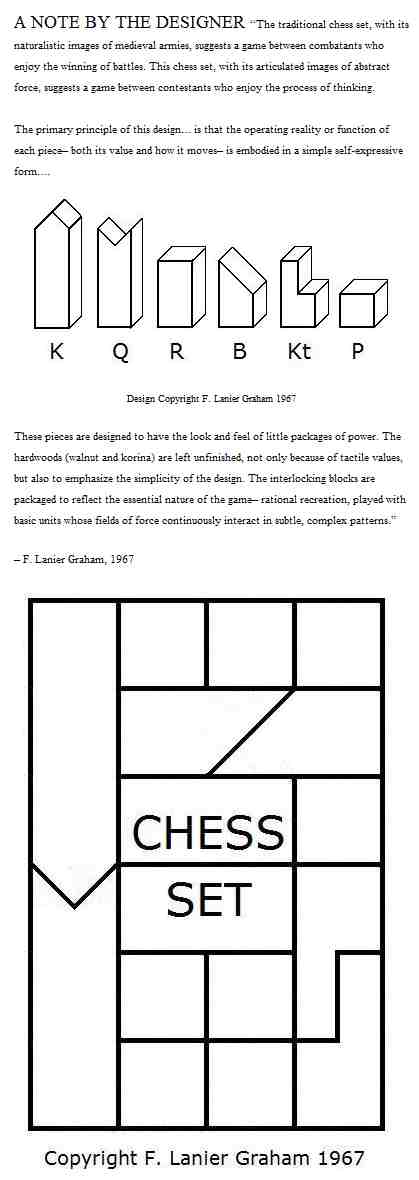
These chessmen appeared in the weblog Minimalissimo
on Sept. 20, 2010. In Log24 on that date, the issue was
not so much the chessmen as the underlying board.
See "The Unfolding." See also the following from
the Occupy Space gallery in Limerick today—
| C A V E S – Anthony Murphy Solo Exhibition Opening 7 pm Thursday 1st Dec Exhibition 2nd – 22nd Dec 2011 Plato's allegory of the cave describes prisoners, inhabiting the cave since childhood, immobile, facing an interior wall. A large fire burns behind the prisoners, and as people pass this fire their shadows are cast upon the cave's wall, and these shadows of the activity being played out behind the prisoner become the only version of reality that the prisoner knows. C A V E S is an exhibition of three large scale works, each designed to immerse the viewer, and then to confront the audience with a question regarding how far they, as privileged viewers of the shadows and reflections being played out upon the walls, are willing to allow themselves to believe what they know to be a false reality. The works are based on explorations of simple 2D shapes; regular polygons are exploded to create fractured pattern, or layered upon one another until intricate forms emerge, upon which the projections can begin to draw out a third dimension. |
Sunday, August 21, 2011
Relativistic Truth
Today's online New York Times on the conclusion of the Roman Catholic Church's "World Youth" week—
"At the end of Sunday’s Mass, the pope announced that the next such event would be in Rio de Janeiro in 2013. Until then, he told those at the service, in Portuguese, that they 'will be swimming against the tide in a society with a relativistic culture, which wishes neither to seek nor hold on to the truth.'*"
* Fact check— This agrees with the Vatican Radio version.
Related material: Relativity Blues and Portal to 1937…

The "Portal" link above is in honor of the May 2 dies natalis of Salomon Bochner (pdf).
For some background, see yesterday's Castles in the Air and Bochner in this journal.
Tuesday, May 3, 2011
Peace and War
This post was suggested by—
- A quotation from Under the Volcano :
"A corpse will be transported by express!" - The wish in a novel by Ernesto Sábato, who died Saturday, April 30,
for a tombstone that says "PEACE" - A statement by another author in this morning's post:
"I think of myself as writing about war," said Robson….
"I try to get away from war, but I can't.
War forces ordinary people to behave extraordinarily."
The above Sábato novel was translated as The Angel of Darkness .
Its Spanish title was "Abaddón el Exterminador " (Abaddon the Exterminator ).
From a customer review of the novel at Amazon.com—
"Early in the book a drunken outcast will see the vision of the Great Beast of Revelation. Near the end he will tell others of what he has seen. Meanwhile Sábato, who was originally trained as a scientist, seeks out the supernatural and the mystical in order to find an antidote to Stalinism, simple-minded 'Progress' and a superficial positivism."
For a more sophisticated vision of the Beast, see The Ninth Gate.
For Abaddon in a less sophisticated antidote to positivism, see The Chronicle of Abaddon the Destroyer: The War in Heaven .
I prefer Charles Williams's approach to War in Heaven .
If there is an afterlife, perhaps Sábato's experience there will be more lively than his novel's tombstone would imply.
He may, despite his wish for heavenly peace, turn out to be (in a phrase from this morning's post) a badly needed "ghost warrior."
Saturday, April 16, 2011
Birthdays
For Pope Benedict XVI and the late Al Sears
Today is the Pope's birthday. Another date of interest—
Al Sears, composer of "Castle Rock," is said to have died at 80 on March 23, 1990. If Sears were a saint, March 23 would be his saint's day— his dies natalis (day of birth into heaven).
For Al—
This morning's post linked to a picture of Alicia Keys's hands at a piano keyboard. Some background from March 23 this year— "Well, she was just 17" and The Heroic Finger.
For the Pope—
Click, as the instructions say,
to look inside.
Tuesday, December 28, 2010
Dry Bones
The webpage of Cullinane College — "For Love of God…."

Related material —
From a post for the opening of Cullinane College on January 29, 2003:
"Young man sings 'Dry Bones'"
Illustrations:
What prompted the above meditation —
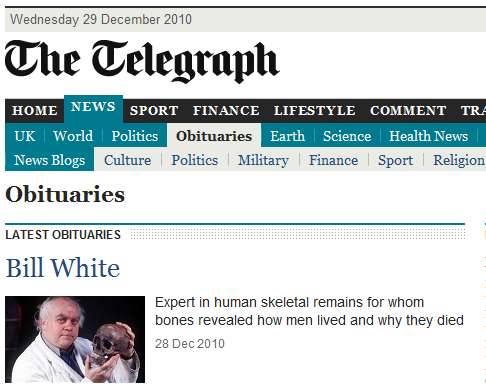
From an obituary of Bill White (who reportedly died at 66 on November 14)—
"During his career, he was consulted by, among others,
the crime writer Patricia Cornwell, and the artist Damien Hirst
(who used his expertise when working on his 2007 piece
For the Love of God, a platinum cast of a skull, encrusted with diamonds)."
Monday, December 13, 2010
Plan 9 Revisited
Leading today's New York Times obituaries —

— is that of Nassos Daphnis, a painter of geometric abstractions
who in 1995 had an exhibition at a Leo Castelli gallery
titled "Energies in Outer Space." (See pictures here.)
Daphnis died, according to the Times, on November 23.
See Art Object, a post in this journal on that date—
There is more than one way
to look at a cube.

Some context— this morning's previous post (Apollo's 13,
on the geometry of the 3×3×3 cube), yesterday's noon post
featuring the 3×3 square grid (said to be a symbol of Apollo),
and, for connoisseurs of the Ed Wood school of cinematic art,
a search in this journal for the phrase "Plan 9."
You can't make this stuff up.
Thursday, December 2, 2010
Caesarian
The Dreidel Is Cast
The Nietzschean phrase "ruling and Caesarian spirits" occurred in yesterday morning's post "Novel Ending."
That post was followed yesterday morning by a post marking, instead, a beginning— that of Hanukkah 2010. That Jewish holiday, whose name means "dedication," commemorates the (re)dedication of the Temple in Jerusalem in 165 BC.
The holiday is celebrated with, among other things, the Jewish version of a die— the dreidel . Note the similarity of the dreidel to an illustration of The Stone* on the cover of the 2001 Eerdmans edition of Charles Williams's 1931 novel Many Dimensions—

For mathematics related to the dreidel , see Ivars Peterson's column on this date fourteen years ago.
For mathematics related (if only poetically) to The Stone , see "Solomon's Cube" in this journal.
Here is the opening of Many Dimensions—
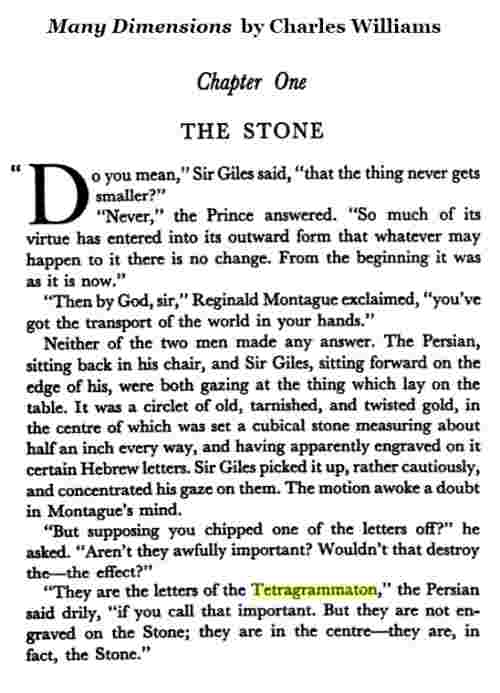
For a fanciful linkage of the dreidel 's concept of chance to The Stone 's concept of invariant law, note that the New York Lottery yesterday evening (the beginning of Hanukkah) was 840. See also the number 840 in the final post (July 20, 2002) of the "Solomon's Cube" search.
Some further holiday meditations on a beginning—
Today, on the first full day of Hanukkah, we may or may not choose to mark another beginning— that of George Frederick James Temple, who was born in London on this date in 1901. Temple, a mathematician, was President of the London Mathematical Society in 1951-1953. From his MacTutor biography—
"In 1981 (at the age of 80) he published a book on the history of mathematics. This book 100 years of mathematics (1981) took him ten years to write and deals with, in his own words:-
those branches of mathematics in which I had been personally involved.
He declared that it was his last mathematics book, and entered the Benedictine Order as a monk. He was ordained in 1983 and entered Quarr Abbey on the Isle of Wight. However he could not stop doing mathematics and when he died he left a manuscript on the foundations of mathematics. He claims:-
The purpose of this investigation is to carry out the primary part of Hilbert's programme, i.e. to establish the consistency of set theory, abstract arithmetic and propositional logic and the method used is to construct a new and fundamental theory from which these theories can be deduced."
For a brief review of Temple's last work, see the note by Martin Hyland in "Fundamental Mathematical Theories," by George Temple, Philosophical Transactions of the Royal Society, A, Vol. 354, No. 1714 (Aug. 15, 1996), pp. 1941-1967.
The following remarks by Hyland are of more general interest—
"… one might crudely distinguish between philosophical and mathematical motivation. In the first case one tries to convince with a telling conceptual story; in the second one relies more on the elegance of some emergent mathematical structure. If there is a tradition in logic it favours the former, but I have a sneaking affection for the latter. Of course the distinction is not so clear cut. Elegant mathematics will of itself tell a tale, and one with the merit of simplicity. This may carry philosophical weight. But that cannot be guaranteed: in the end one cannot escape the need to form a judgement of significance."
— J. M. E. Hyland. "Proof Theory in the Abstract." (pdf)
Annals of Pure and Applied Logic 114, 2002, 43-78.
Here Hyland appears to be discussing semantic ("philosophical," or conceptual) and syntactic ("mathematical," or structural) approaches to proof theory. Some other remarks along these lines, from the late Gian-Carlo Rota—
See also "Galois Connections" at alpheccar.org and "The Galois Connection Between Syntax and Semantics" at logicmatters.net.
* Williams's novel says the letters of The Stone are those of the Tetragrammaton— i.e., Yod, He, Vau, He (cf. p. 26 of the 2001 Eerdmans edition). But the letters on the 2001 edition's cover Stone include the three-pronged letter Shin , also found on the dreidel . What esoteric religious meaning is implied by this, I do not know.
Wednesday, March 17, 2010
Prime Directive
Rigor
“317 is a prime, not because we think so,
or because our minds are shaped in one way
rather than another, but because it is so,
because mathematical reality is built that way.”
– G. H. Hardy,
A Mathematician’s Apology

The above photo is taken from
a post in this journal dated
March 10, 2010.
This was, as the Pope might say,
the dies natalis of a master gameplayer–
| New York Times, March 16, 2010–
Tim Holland, Backgammon Master, Tim Holland, who was widely considered the world’s greatest backgammon player during that ancient board game’s modern heyday, in the 1960s and ’70s, died on March 10 at his home in West Palm Beach, Fla. He was 79. <<more>> |
In Holland's honor, a post
from Columbus Day, 2004—
Tuesday October 12, 200411:11 PM Time and Chance
Today’s winning lottery numbers
|
A quote from Holland on backgammon–
"It’s the luck factor that seduces everyone
into believing that they are good,
that they can actually win,
but that’s just wishful thinking."
For those who are, like G.H. Hardy,
suspicious of wishful thinking,
here is a quote and a picture from
Holland's ordinary birthday, March 3—
"The die is cast." — Caesar
Saturday, March 13, 2010
ART WARS continued…
Wikipedia states that painter R.B. Kitaj (see previous references) was the model for the protagonist of the Philip Roth novel Sabbath's Theater.
A Google search shows that the article (no longer online) on Kitaj cited as a source by Wikipedia does indeed make this claim–
In-Your-Face Outsider | Jerusalem Report | Jerusalem Post
By MATT NESVISKY … not least, Philip Roth, who modeled
the protagonist of the 1995 novel "Sabbath's Theater" largely after Kitaj. …
www.jpost.com/servlet/Satellite?apage=2&cid=1192380767901…
The rest of Nesvisky's article may or may not support his claim. It is available by subscribing to HighBeam.
Related material–
The New York Times on Oct. 24, 2007–
R. B. Kitaj, Painter of Moody Human Dramas, Dies at 74Ileana Sonnabend, Art World Figure, Dies at 92Ileana Sonnabend’s eye, shrewdness and lasting alliance with her first husband, Leo Castelli, made her one of the most formidable contemporary art dealers of her time. |
"Sonnabend" means "Saturday" in German.
Some say the Sabbath is Saturday, others say Sunday.
Here is the Log24 entry for the day that
Kitaj and Sonnabend died– a Sunday—
Sunday October 21, 2007Halloween “The Game in the Ship cannot be approached as a job, a vocation, a career, or a recreation. To the contrary, it is Life and Death itself at work there. In the Inner Game, we call the Game Dhum Welur, the Mind of God. And that Mind is a terrible mind, that one may not face directly and remain whole. Some of the forerunners guessed it long ago– first the Hebrews far back in time, others along the way, and they wisely left it alone, left the Arcana alone.”
|
The New York Times on Sonnabend:
… Also talked about was the Sonnabend 1991 show of Jeff Koons’s “Made in Heaven” series of paintings and sculptures that showed the artist engaged in sexual acts with his wife, Ilona Staller.
Mrs. Sonnabend was variously described as “an iron marshmallow” and “a cross between Buddha and Machiavelli.” Short and plump, she was grandmotherly in appearance from a relatively early age due in part to an illness that necessitated a wig.
Her genteel, old Europe manner belied an often imperious yet bohemian and self-deprecating personality. Her soft, fluty voice often left a listener unprepared for the force of her comments, which she could deliver in at least five languages.
Happy Women's History Month.
Wednesday, March 3, 2010
Plato’s Ghost
Jeremy Gray, Plato's Ghost: The Modernist Transformation of Mathematics, Princeton, 2008–
"Here, modernism is defined as an autonomous body of ideas, having little or no outward reference, placing considerable emphasis on formal aspects of the work and maintaining a complicated— indeed, anxious— rather than a naïve relationship with the day-to-day world, which is the de facto view of a coherent group of people, such as a professional or discipline-based group that has a high sense of the seriousness and value of what it is trying to achieve. This brisk definition…."
Brisk? Consider Caesar's "The die is cast," Gray in "Solomon's Cube," and yesterday's post—
This is the group of "8 rigid motions
generated by reflections in midplanes"
of Solomon's Cube.
Related material:
"… the action of G168 in its alternative guise as SL(3; Z/2Z) is also now apparent. This version of G168 was presented by Weber in [1896, p. 539],* where he attributed it to Kronecker."
— Jeremy Gray, "From the History of a Simple Group," in The Eightfold Way, MSRI Publications, 1998
Here MSRI, an acronym for Mathematical Sciences Research Institute, is pronounced "Misery." See Stephen King, K.C. Cole, and Heinrich Weber.
*H. Weber, Lehrbuch der Algebra, Vieweg, Braunschweig, 1896. Reprinted by Chelsea, New York, 1961.
Friday, February 12, 2010
Capital E
Where Entertainment is God, continued—
The following paragraphs are from a review by Piotr Siemion of Infinite Jest, a novel by David Foster Wallace. Illustrations have been added.
"Wallace was somehow able to twist together three yarns…. …there's a J.D Salinger for those who like J.D. Salinger. There's William Burroughs for those hardy souls who like some kick in their prose. And there's a dash of Kurt Vonnegut too. All three voices, though, are amplified in Infinite Jest beyond mere distortion and then projected onto Wallace's peculiar own three-ring circus….
… there's entertainment. Make it a capital E.
Illustration by Clint Eastwood
from Log24 post "E is for Everlast"
Infinite Jest revolves, among its many gyrations, around the story of the Entertainment, a film-like creation going by the title of 'Infinite Jest' and created shortly before his suicidal death by the young tennis star's father. The Entertainment's copies are now being disseminated clandestinely all over Wallace's funny America. Problem is, of course, that the film is too good. Anybody who gets to watch it becomes hooked instantly and craves only to watch it again, and again, and again, until the audience drops dead of exhaustion and hunger. Why eat when you're entertained by such a good movie? Wallace's premise brings you back to that apocryphal lab experiment in which rats were treated to a similar choice. When the rat pushed one button, marked FOOD, it would get a food pellet. The other button, marked FUN, would fire up an electrode rigged right into the orgasm center somewhere in the rat's cortex. Needless to add, one rat after another would drop dead from hunger, still twitching luridly and trying to finesse one last push of the button. Same thing in Wallace's story, especially that even those characters who have not seen the Entertainment yet, keep on entertaining themselves by different means."
The title of the Entertainment, "Infinite Jest," might also be applied to a BBC program featuring mathematician Peter J. Cameron. The program's actual title was "To Infinity and Beyond." It was broadcast the night of Feb. 10 (the date of this journal's previous post).
Few, however, are likely to find the Infinity program addictive. For closer approaches to Wallace's ideal Entertainment, see instead Dante (in the context of this journal's Feb. 4 posts on Cameron and the afterlife) and the BBC News.
Friday, July 31, 2009
Friday July 31, 2009
| ALLURE |
at The New York Times.
For previous notes on
allure at the Times, see
St. Luke’s Day, 2008,
and its links.
Teaser at the top of
this afternoon’s Times’s
online front page:
“Vampires Never Die:
In our fast-paced society,
eternity has a special
allure.” (With fanged
illustration)–

Yesterday’s afternoon entry was
related to both the July 13th death
of avant-garde artist Dash Snow
and the beauty of Suzanne Vega.
A reference to Vega’s album
“Beauty & Crime” apppeared here
on the date of Snow’s death.
(See “Terrible End for an
Enfant Terrible,” NY Times,
story dated July 24.)
The Vega entry yesterday was, in
part, a reference to that context.

In view of today’s Times
teaser, the large picture of
Vega shown here yesterday
(a detail of the above cover)
seems less an image of
pure beauty than of, well,
a lure… specifically, a
vampire lure:

What healthy vampire
could resist that neck?
To me, the key words in the
Times teaser are “allure”
(discussed above) and “eternity.”
For both allure and eternity
in the same picture
(with interpretive
symbols added above)
see this journal on
January 31, 2008:


This image from “Black Narcissus”
casts Jean Simmons as Allure
and Deborah Kerr, in a pretty
contrast, as Eternity.
For different approaches to
these concepts, see Simmons
and Kerr in other films,
notably those co-starring
Burt Lancaster.
Lancaster seems to have had
a pretty good grasp of Allure
in his films with Simmons
and Kerr. For Eternity, see
“Rocket Gibraltar” and
“Field of Dreams.”
For less heterosexual approaches
to these concepts, see the
continuing culture coverage of
the Times— for instance, the
vampire essay above and the
Times‘s remarks Monday on
choreographer Merce Cunningham–
who always reminded me of
Carmen Ghia in “The Producers”–

Related material:
“Dance of the Vampires”
in “At the Still Point”
(this journal, 1/16/03).
Tuesday, July 28, 2009
Tuesday July 28, 2009
Anniversary

The Associated Press this morning —
“Today’s Highlight in History:
Plot summary by “Anonymous” at imdb.com of a feminist film version of “The Tempest” (now in post-production):
Taymor’s “Tempest” stars, as Prospera, the famed portrayer of monarchs Helen Mirren. Another work dealing with alchemy suitable for Mirren (who is also known as Detective Inspector Jane Tennison):

Thursday, May 21, 2009
Thursday May 21, 2009
Cast:
 |
Die (Tony Smith) |
|
|
Paul Moore, Jr., retired Episcopal Bishop of New York, who died at home at 83 on the First of May, 2003 |
From “Secondary Structures,” by Tom Moody, Sculpture Magazine, June 2000:
“By the early ’90s, the perception of Minimalism as a ‘pure’ art untouched by history lay in tatters. The coup de grâce against the movement came not from an artwork, however, but from a text. Shortly after the removal of Richard Serra’s Tilted Arc from New York City’s Federal Plaza, Harvard art historian Anna Chave published ‘Minimalism and the Rhetoric of Power’ (Arts Magazine, January 1990), a rousing attack on the boys’ club that stops just short of a full-blown ad hominem rant. Analyzing artworks (Walter de Maria’s aluminum swastika, Morris’s ‘carceral images,’ Flavin’s phallic ‘hot rods’), critical vocabulary (Morris’s use of ‘intimacy’ as a negative, Judd’s incantatory use of the word ‘powerful’), even titles (Frank Stella’s National Socialist-tinged Arbeit Macht Frei and Reichstag), Chave highlights the disturbing undercurrents of hypermasculinity and social control beneath Minimalism’s bland exterior. Seeing it through the eyes of the ordinary viewer, she concludes that ‘what [most] disturbs [the public at large] about Minimalist art may be what disturbs them about their own lives and times, as the face it projects is society’s blankest, steeliest face; the impersonal face of technology, industry and commerce; the unyielding face of the father: a face that is usually far more attractively masked.'”
For a more attractively masked father figure, see the Terminator series:

For further religious background,
see “Jesus and the Terminator“
in Christianity Today.
Sunday, April 5, 2009
Sunday April 5, 2009
About the People:
Race to Witch Mountain
— President Obama in Strasbourg on Friday, April 3, 2009
"George Bernard Shaw once wrote, 'Some people see things as they are and say why? I dream things that never were and say, why not?'"
— Robert Kennedy, University of Kansas, March 18, 1968
|
George Bernard Shaw:
THE SNAKE. I can talk of many things. I am very wise. It was I who whispered the word to you that you did not know. Dead. Death. Die. EVE [shuddering] Why do you remind me of it? I forgot it when I saw your beautiful hood. You must not remind me of unhappy things. THE SERPENT. Death is not an unhappy thing when you have learnt how to conquer it. EVE. How can I conquer it? THE SERPENT. By another thing, called birth. EVE. What? [Trying to pronounce it] B-birth? THE SERPENT. Yes, birth. EVE. What is birth? THE SERPENT. The serpent never dies. Some day you shall see me come out of this beautiful skin, a new snake with a new and lovelier skin. That is birth. EVE. I have seen that. It is wonderful. THE SERPENT. If I can do that, what can I not do? I tell you I am very subtle. When you and Adam talk, I hear you say 'Why?' Always 'Why?' You see things; and you say 'Why?' But I dream things that never were; and I say 'Why not?' I made the word dead to describe my old skin that I cast when I am renewed. I call that renewal being born. EVE. Born is a beautiful word. THE SERPENT. Why not be born again and again as I am, new and beautiful every time? EVE. I! It does not happen: that is why. THE SERPENT. That is how; but it is not why. Why not? EVE. But I should not like it. It would be nice to be new again; but my old skin would lie on the ground looking just like me; and Adam would see it shrivel up and– THE SERPENT. No. He need not. There is a second birth. EVE. A second birth? THE SERPENT. Listen. I will tell you a great secret…. |
"Listen, I tell you a mystery…."
— Saul of Tarsus
About the People
(with apologies to
Zenna Henderson):
"We've got to stop meeting like this."
Monday, February 23, 2009
Monday February 23, 2009
McGee and Smee
| Project MUSE — … and interpretations, “any of the Zingari shoolerim [gypsy schoolchildren] may pick a peck of kindlings yet from the sack of auld hensyne” (FW 112.4-8). … — Patrick McGee, “Reading Authority: |
“The ulterior motive behind this essay [“Reading Authority,” above], the purpose for which I seize this occasion, concerns the question or problem of authority. I stress at the outset my understanding of authority as the constructed repository of value or foundation of a system of values, the final effect of fetishism– in this case, literary fetishism. [Cf. Marx, Das Kapital] Reading– as in the phrase ‘reading authority’– should be grasped as the institutionally determined act of constructing authority….”
“[In Peter Pan] Smee is Captain Hook’s right-hand man… Barrie describes him as ‘Irish’ and ‘a man who stabbed without offence‘….”
Background: In yesterday’s morning entry, James Joyce as Jesuit, with “Dagger Definitions.”
A different Smee appears as an art critic in yesterday’s afternoon entry “Design Theory.”–
“Brock, who has a brisk mind, is a man on a mission. He read mathematical economics and political philosophy at Princeton (he has five degrees in all) and is the founder and president of Strategic Economic Decisions Inc., a think tank specializing in applying the economics of uncertainty to forecasting and risk assessment.
But phooey to all that; Brock has deeper things to think about. He believes he has cracked the secret of beautiful design. He even has equations and graphs to prove it.”
A Jesuit in Portrait of the Artist as a Young Man:
“When may we expect to have something from you on the esthetic question?”
“Our entanglement in the wilderness of Finnegans Wake is exemplified by the neologism ‘Bethicket.’ This word condenses a range of possible meanings and reinforces a diversity of possible syntactic interpretations. Joyce seems to allude to Beckett, creating a portmanteau word that melds ‘Beckett’ with ‘thicket’ (continuing the undergrowth metaphor), ‘thick’ (adding mental density to floral density)…. As a single word ‘Bethicket’ contains the confusion that its context suggests. On the one hand, ‘Bethicket me for a stump of a beech’ has the sound of a proverbial expletive that might mean something like ‘I’ll be damned’ or ‘Well, I’ll be a son of a gun.’….”

At the Oscars, 2009
Related material:Frame Tales and Dickung
Tuesday, December 23, 2008
Tuesday December 23, 2008
Kindred Spirit
On the late film director Robert Mulligan, who died early Saturday [Dec. 20, 2008] at 83:
Mulligan received a best director Oscar nomination in 1963 for “[To Kill a] Mockingbird”….
While some debated whether he had a discernible personal vision in his films, Mulligan was known for his casting and direction of children, including “[Up the Down] Staircase,” where he personally interviewed more than 500 New York high school students.
Sensing a kindred spirit, Francois Truffaut was a vocal champion, particularly cognizant of what he perceived as undue criticism of Mulligan’s work for lacking a particular “style.” Mulligan himself was dismissive of critics/cineaste talk: “I don’t know anything about ‘the Mulligan style,’ ” he told the Village Voice in 1978. “If you can find it, well, that’s your job.”
Thanks to desconvencida for a trailer of “The Man in the Moon” (1991), Reese Witherspoon’s first film and Mulligan’s last.
Mulligan also directed Natalie Wood in a personal favorite of mine, “Love with the Proper Stranger.”
Monday, August 4, 2008
Monday August 4, 2008
Summer of ’36
Another Opening
of Another Show
“When I cast my mind back to that summer of 1936 different kinds of memories offer themselves to me. We got our first wireless set that summer– well, a sort of a set; and it obsessed us. And because it arrived as August was about to begin, my Aunt Maggie– she was the joker of the family– she suggested we give it a name. She wanted to call it Lugh after the old Celtic God of the Harvest. Because in the old days August the First was La Lughnasa, the feast day of the pagan god, Lugh; and the days and weeks of harvesting that followed were called the Festival of Lughnasa.”
“Dancing at Lughnasa”
From the film “Contact”–
Jodie Foster and the
opening of the 1936 Olympics
| “Heraclitus…. says: ‘The ruler whose prophecy occurs at Delphi oute legei oute kryptei, neither gathers nor hides, alla semainei, but gives hints.'” — An Introduction to Metaphysics, by Martin Heidegger, Yale University Press paperback, 1959, p. 170 |
Sunday, May 25, 2008
Sunday May 25, 2008
Epigraph to
“Deploying the Glass Bead Game, Part II,”
by Robert de Marrais:
“For a complete logical argument,”
Arthur began
with admirable solemnity,
“we need two prim Misses –”
“Of course!” she interrupted.
“I remember that word now.
And they produce — ?”
“A Delusion,” said Arthur.
— Lewis Carroll,
Sylvie and Bruno
Erin O’Connor’s weblog “Critical Mass” on May 24:
Roger Rosenblatt’s Beet [Ecco hardcover, Jan. 29, 2008] is the latest addition to the noble sub-genre of campus fiction….
Curricular questions and the behavior of committees are at once dry as dust subjects and areas ripe for sarcastic send-up– not least because, as dull as they are, they are really both quite vital to the credibility and viability of higher education.
Here’s an excerpt from the first meeting, in which committee members propose their personal plans for a new, improved curriculum:
“… Once the students really got into playing with toy soldiers, they would understand history with hands-on excitement.”
To demonstrate his idea, he’d brought along a shoe box full of toy doughboys and grenadiers, and was about to reenact the Battle of Verdun on the committee table when Heilbrun stayed his hand. “We get it,” he said.
“That’s quite interesting, Molton,” said Booth [a chemist]. “But is it rigorous enough?”
At the mention of the word, everyone, save Peace, sat up straight.
“Rigor is so important,” said Kettlegorf.
“We must have rigor,” said Booth.
“You may be sure,” said the offended Kramer. “I never would propose anything lacking rigor.”
Smythe inhaled and looked at the ceiling. “I think I may have something of interest,” he said, as if he were at a poker game and was about to disclose a royal flush. “My proposal is called ‘Icons of Taste.’ It would consist of a galaxy of courses affixed to several departments consisting of lectures on examples of music, art, architecture, literature, and other cultural areas a student needed to indicate that he or she was sophisticated.”
“Why would a student want to do that?” asked Booth.
“Perhaps sophistication is not a problem for chemists,” said Smythe. Lipman tittered.
“What’s the subject matter?” asked Heilbrun. “Would it have rigor?”
“Of course it would have rigor. Yet it would also attract those additional students Bollovate is talking about.” Smythe inhaled again. “The material would be carefully selected,” he said. “One would need to pick out cultural icons the students were likely to bring up in conversation for the rest of their lives, so that when they spoke, others would recognize their taste as being exquisite yet eclectic and unpredictable.”
“You mean Rembrandt?” said Kramer.
Smythe smiled with weary contempt. “No, I do not mean Rembrandt. I don’t mean Beethoven or Shakespeare, either, unless something iconic has emerged about them to justify their more general appeal.”
“You mean, if they appeared on posters,” said Lipman.
“That’s it, precisely.”
Lipman blushed with pride.
“The subject matter would be fairly easy to amass,” Smythe said. “We could all make up a list off the top of our heads. Einstein–who does have a poster.” He nodded to the ecstatic Lipman. “Auden, for the same reason. Students would need to be able to quote ‘September 1939[ or at least the last lines. And it would be good to teach ‘Musee des Beaux Arts’ as well, which is off the beaten path, but not garishly. Mahler certainly. But Cole Porter too. And Sondheim, I think. Goya. Warhol, it goes without saying, Stephen Hawking, Kurosawa, Bergman, Bette Davis. They’d have to come up with some lines from Dark Victory, or better still, Jezebel. La Dolce Vita. Casablanca. King of Hearts. And Orson, naturally. Citizen Kane, I suppose, though personally I prefer F for Fake.”
“Judy!” cried Heilbrun.
“Yes, Judy too. But not ‘Over the Rainbow.’ It would be more impressive for them to do ‘The Trolley Song,’ don’t you think?” Kettlegorf hummed the intro.
“Guernica,” said Kramer. “Robert
Capa.” “Edward R. Murrow,” said Lipman.
“No! Don’t be ridiculous!” said Smythe, ending Lipman’s brief foray into the world of respectable thought.
“Marilyn Monroe!” said Kettlegorf.
“Absolutely!” said Smythe, clapping to indicate his approval.
“And the Brooklyn Bridge,” said Booth, catching on. “And the Chrysler Building.”
“Maybe,” said Smythe. “But I wonder if the Chrysler Building isn’t becoming something of a cliche.”
Peace had had enough. “And you want students to nail this stuff so they’ll do well at cocktail parties?”
Smythe sniffed criticism, always a tetchy moment for him. “You make it sound so superficial,” he said.
Prim Miss 2:
Siri Hustvedt speaks at Adelaide Writers’ Week– a story dated March 24,
“I have come to think of my books as echo chambers or halls of mirrors in which themes, ideas, associations continually reflect and reverberate inside a text. There is always point and counterpoint, to use a musical illustration. There is always repetition with difference.”
A Delusion:
Exercise — Identify in the following article the sentence that one might (by unfairly taking it out of context) argue is a delusion.
(Hint: See Reflection Groups in Finite Geometry.)

Why Borovik’s Figure 4
is included above:
No Royal Roads.
For more on Prim Miss 2
and deploying
the Glass Bead Game,
see the previous entry.
 And now, perhaps, his brother Cornell Capa, who died Friday.
And now, perhaps, his brother Cornell Capa, who died Friday.† Related material: Log24 on March 24– Death and the Apple Tree— with an excerpt from George MacDonald, and an essay by David L. Neuhouser mentioning the influence of MacDonald on Lewis Carroll– Lewis Carroll: Author, Mathematician, and Christian (pdf).
Friday, December 14, 2007
Friday December 14, 2007
“Well, it changes.”
A related Log24 link from
that same date, November 27:
Motorcycle Maintenance —
“Plato hadn’t tried to destroy areté. He had encapsulated it; made a permanent, fixed Idea out of it; had converted it to a rigid, immobile Immortal Truth. He made areté the Good, the highest form, the highest Idea of all. It was subordinate only to Truth itself, in a synthesis of all that had gone before.That was why the Quality that Phaedrus had arrived at in the classroom had seemed so close to Plato’s Good. Plato’s Good was taken from the rhetoricians. Phaedrus searched, but could find no previous cosmologists who had talked about the Good. That was from the Sophists. The difference was that Plato’s Good was a fixed and eternal and unmoving Idea, whereas for the rhetoricians it was not an Idea at all. The Good was not a form of reality. It was reality itself, ever changing, ultimately unknowable in any kind of fixed, rigid way.”
— as well as Cold Mountain —
you take a mirror and look
backwards into a well, you’ll
see your future down in the water.”
“So in short order Ada found herself bent backward over the mossy well lip, canted in a pose with little to recommend it in the way of dignity or comfort, back arched, hips forward, legs spraddled for balance. She held a hand mirror above her face, angled to catch the surface of the water below.
Ada had agreed to the well-viewing as a variety of experiment in local custom and as a tonic for her gloom. Her thoughts had been broody and morbid and excessively retrospective for so long that she welcomed the chance to run counter to that flow, to cast forward and think about the future, even though she expected to see nothing but water at the bottom of the well.
She shifted her feet to find better grip on the packed dirt of the yard and then tried to look into the mirror. The white sky above was skimmed over with backlit haze, bright as a pearl or as a silver mirror itself. The dark foliage of oaks all around the edges framed the sky, duplicating the wooden frame of the mirror into which Ada peered, examining its picture of the well depths behind her to see what might lie ahead in her life. The bright round of well water at the end of the black shaft was another mirror. It cast back the shine of sky and was furred around the edges here and there with sprigs of fern growing between stones.
Ada tried to focus her attention on the hand mirror, but the bright sky beyond kept drawing her eye away. She was dazzled by light and shade, by the confusing duplication of reflections and of frames. All coming from too many directions for the mind to take account of. The various images bounced against each other until she felt a desperate vertigo, as if she could at any moment pitch backward and plunge head first down the well shaft and drown there, the sky far above her, her last vision but a bright circle set in the dark, no bigger than a full moon.
Her head spun and she reached with her free hand and held to the stonework of the well. And then just for a moment things steadied, and there indeed seemed to be a picture in the mirror.”
— and Log24 on December 3 —
Saturday, November 24, 2007
Saturday November 24, 2007
standards of seriousness
is almost complete.”
— Susan Sontag
Doonesbury 11/23/07:

For standards of comedy,
see Angels in Arabia.
For standards of tragicomedy,
see Molly Ivins on the owner
of Condé Nast Publications:
‘I think Si Newhouse has
lost his moral compass
since Roy Cohn died.'”
— Molly Ivins
|
|
Happy Holidays from Roy Cohn,
Mike Nichols, Al Pacino, and Elvis:

The magazine, which covers music and its impact on filmmaking, launches in November as a supplement in the December subscriber issues of 14 Condé Nast publications.”
Wednesday, October 24, 2007
Wednesday October 24, 2007
New York Times—
R. B. Kitaj, Painter of Moody Human Dramas, Dies at 74
|
Tuesday, October 16, 2007
Tuesday October 16, 2007
Harish-Chandra,
who died at 60
on this date in 1983

Harish-Chandra in 1981
(Photo by Herman Landshof)
As a corrective to the previous parodies here, the following material on the mathematician Harish-Chandra may help to establish that there is, in fact, such a thing as “deep beauty”– if not in physics, religion, or philosophy, at least in pure mathematics.
MacTutor History of Mathematics:
“Harish-Chandra worked at the Institute of Advanced Study at Princeton from 1963. He was appointed IBM-von Neumann Professor in 1968.”
R. P. Langlands (pdf, undated, apparently from a 1983 memorial talk):
“Almost immediately upon his arrival in Princeton he began working at a ferocious pace, setting standards that the rest of us may emulate but never achieve. For us there is a welter of semi-simple groups: orthogonal groups, symplectic groups, unitary groups, exceptional groups; and in our frailty we are often forced to treat them separately. For him, or so it appeared because his methods were always completely general, there was a single group. This was one of the sources of beauty of the subject in his hands, and I once asked him how he achieved it. He replied, honestly I believe, that he could think no other way. It is certainly true that he was driven back upon the simplifying properties of special examples only in desperate need and always temporarily.”
“It is difficult to communicate the grandeur of Harish-Chandra’s achievements and I have not tried to do so. The theory he created still stands– if I may be excused a clumsy simile– like a Gothic cathedral, heavily buttressed below but, in spite of its great weight, light and soaring in its upper reaches, coming as close to heaven as mathematics can. Harish, who was of a spiritual, even religious, cast and who liked to express himself in metaphors, vivid and compelling, did see, I believe, mathematics as mediating between man and what one can only call God. Occasionally, on a stroll after a seminar, usually towards evening, he would express his feelings, his fine hands slightly upraised, his eyes intent on the distant sky; but he saw as his task not to bring men closer to God but God closer to men. For those who can understand his work and who accept that God has a mathematical side, he accomplished it.”
For deeper views of his work, see
- Rebecca A. Herb, “Harish-Chandra and His Work” (pdf), Bulletin of the American Mathematical Society, July 1991, and
- R. P. Langlands, “Harish-Chandra, 1923-1983” (pdf, 28 pp., Royal Society memoir, 1985)
Wednesday, July 25, 2007
Wednesday July 25, 2007
George Tabori
Filed with The New York Times
at 11:16 p.m. ET July 24, 2007–
George Tabori
“BERLIN (AP) — Hungarian-born playwright and director George Tabori, a legend in Germany’s postwar theater world whose avant-garde works confronted anti-Semitism, died Monday [July 23, 2007]. He was 93.
Tabori, who as recently as three years ago dreamed of returning to stage to play the title role in Shakespeare’s ‘King Lear,’ died in his apartment near the theater, the Berliner Ensemble said Tuesday, noting that friends and family had accompanied him through his final days. No cause of death was given.
Born into a Jewish family in Budapest on May 24, 1914, Tabori fled in 1936 to London, where he started working for the British Broadcasting Corp., and became a British citizen. His father, and other members of his family, were killed at Auschwitz.
Tabori moved to Hollywood in the 1950s, where he worked as a scriptwriter, most notably co-writing the script for Alfred Hitchcock’s 1953 film, ‘I Confess.’
He moved to Germany in the 1970s and launched a theater career that spanned from acting to directing to writing. He used sharp wit and humor in his plays to examine the relationship between Germany and the Jews, as well as attack anti-Semitism.
Among his best-known works are ‘Mein Kampf,’ set in the Viennese hostel where Adolf Hitler lived from 1910-1913, and the ‘Goldberg Variations,’ both dark farces that poke fun at the Nazis.”
From Year of Jewish Culture:
“The year 2006 marks the 100th anniversary of the establishment of the Jewish Museum in Prague.”
From the related page Programme (October-December):
“Divadlo v Dlouhé
George Tabori: GOLDBERGOVSKÉ VARIACE / THE GOLDBERG VARIATIONS, 19 October, 7 p.m. A comedy on creation and martyrdom.”
|
From Log24 on the date of 
The above is from Variable Resolution 4–k Meshes: Concepts and Applications (pdf), by Luiz Velho and Jonas Gomes. See also Symmetry Framed |
|
Theme (Plato, Meno)
 Click on “variations” above |
Tuesday, July 3, 2007
Tuesday July 3, 2007
of Stanley Fish
(continued from
June 18, 2002)
The “ignorance” referred to
is Fish’s ignorance of the
philosophical background
of the words
“particular” and “universal.”
The Ignorance of Our
Warrior Intellectuals,”
by Stanley Fish,
Harper’s Magazine,
July 2002, contains
the following passages:
“Although it may not at first be obvious, the substitution for real religions of a religion drained of particulars is of a piece with the desire to exorcise postmodernism.”
“What must be protected, then, is the general, the possibility of making pronouncements from a perspective at once detached from and superior to the sectarian perspectives of particular national interests, ethnic concerns, and religious obligations; and the threat to the general is posed by postmodernism and strong religiosity alike, postmodernism because its critique of master narratives deprives us of a mechanism for determining which of two or more fiercely held beliefs is true (which is not to deny the category of true belief, just the possibility of identifying it uncontroversially), strong religiosity because it insists on its own norms and refuses correction from the outside. The antidote to both is the separation of the private from the public, the establishing of a public sphere to which all could have recourse and to the judgments of which all, who are not criminal or insane, would assent. The point of the public sphere is obvious: it is supposed to be the location of those standards and measures that belong to no one but apply to everyone. It is to be the location of the universal. The problem is not that there is no universal–the universal, the absolutely true, exists, and I know what it is. The problem is that you know, too, and that we know different things, which puts us right back where we were a few sentences ago, armed with universal judgments that are irreconcilable, all dressed up and nowhere to go for an authoritative adjudication.
What to do? Well, you do the only thing you can do, the only honest thing: you assert that your universal is the true one, even though your adversaries clearly do not accept it, and you do not attribute their recalcitrance to insanity or mere criminality–the desired public categories of condemnation–but to the fact, regrettable as it may be, that they are in the grip of a set of beliefs that is false. And there you have to leave it, because the next step, the step of proving the falseness of their beliefs to everyone, including those in their grip, is not a step available to us as finite situated human beings. We have to live with the knowledge of two things: that we are absolutely right and that there is no generally accepted measure by which our rightness can be independently validated. That’s just the way it is, and we should just get on with it, acting in accordance with our true beliefs (what else could we do?) without expecting that some God will descend, like the duck in the old Groucho Marx TV show, and tell us that we have uttered the true and secret word.”
From the public spheres
of the Pennsylvania Lottery:


“‘From your lips
to God’s ears,’
goes the old
Yiddish wish.
The writer, by contrast,
tries to read God’s lips
and pass along
the words….”
— Richard Powers
268 —
This is a page number
that appears, notably,
in my June 2002
journal entry on Fish,
and again in an entry,
“The Transcendent Signified,”
dated July 26, 2003,
that argues against
Fish’s school, postmodernism,
and in favor of what the pomos
call “logocentrism.”
Page 268
of Simon Blackburn’s Think
(Oxford Univ. Press, 1999):
regard the particular
page number 268 as
delivered– five years late,
but such is philosophy–
by Groucho’s
winged messenger
in response to
Fish’s utterance of the
“true and secret word”–
namely, “universal.”
When not arguing politics,
Fish, though from
a Jewish background, is
said to be a Milton scholar.
Let us therefore hope he
is by now, or comes to be,
aware of the Christian
approach to universals–
an approach true to the
philosophical background
sketched in 1999 by
Blackburn and made
particular in a 1931 novel
by Charles Williams,
The Place of the Lion.
Saturday, June 30, 2007
Saturday June 30, 2007
November 2004–

Controversial "Desperate Housewives"… ranks No. 5 among all prime-time shows for ages 12-17. ("Monday Night Football" is No. 18.) This may explain in part why its current advertisers include products like Fisher-Price toys, the DVD of "Elf" and the forthcoming Tim Allen holiday vehicle, "Christmas With the Kranks." Those who cherish the First Amendment can only hope that the Traditional Values Coalition, OneMillionMoms.com, OneMillionDads.com and all the rest send every e-mail they can to the F.C.C. demanding punitive action against the stations that broadcast "Desperate Housewives." A "moral values" crusade that stands between a TV show this popular and its audience will quickly learn the limits of its power in a country where entertainment is god. — "The Great Indecency Hoax," a New York Times column by Frank Rich quoted in Log24 on Nov. 26, 2004 |
The entertainment continues. A rabbi's obituary in today's New York Times (see previous entry) served as ad-bait for "Joshua," a Fox Searchlight film opening July 6.
A search for a less sacrilegious memorial to the rabbi yields the following:

The "Project MUSE" link above
works only at
subscribing libraries.
It seems that here, too,
the rabbi is being
used as bait.
For a perhaps preferable
reference to bait, in the
context of St. Peter as
a "fisher of men," see
the Christian "mandorla"
or "vesica piscis,"
a figure hidden within
the geometry of Rome's
St. Peter's Square–
which, despite its name,
is an oval:

For the geometric
construction of the
Roman oval, see
"ovato tondo" in
Rudolf Arnheim's
The Power of the Center.
For a less theoretical account
of the religious significance
of the mandorla, see
the 2001 film
The Center of the World.
Tuesday, February 20, 2007
Tuesday February 20, 2007
Today is the 21st birthday of my note “The Relativity Problem in Finite Geometry.”
Some relevant quotations:
“This is the relativity problem: to fix objectively a class of equivalent coordinatizations and to ascertain the group of transformations S mediating between them.”
— Hermann Weyl, The Classical Groups, Princeton University Press, 1946, p. 16
Describing the branch of mathematics known as Galois theory, Weyl says that it
“… is nothing else but the relativity theory for the set Sigma, a set which, by its discrete and finite character, is conceptually so much simpler than the infinite set of points in space or space-time dealt with by ordinary relativity theory.”
— Weyl, Symmetry, Princeton University Press, 1952, p. 138
Weyl’s set Sigma is a finite set of complex numbers. Some other sets with “discrete and finite character” are those of 4, 8, 16, or 64 points, arranged in squares and cubes. For illustrations, see Finite Geometry of the Square and Cube. What Weyl calls “the relativity problem” for these sets involves fixing “objectively” a class of equivalent coordinatizations. For what Weyl’s “objectively” means, see the article “Symmetry and Symmetry Breaking,” by Katherine Brading and Elena Castellani, in the Stanford Encyclopedia of Philosophy:
“The old and natural idea that what is objective should not depend upon the particular perspective under which it is taken into consideration is thus reformulated in the following group-theoretical terms: what is objective is what is invariant with respect to the transformation group of reference frames, or, quoting Hermann Weyl (1952, p. 132), ‘objectivity means invariance with respect to the group of automorphisms [of space-time].‘[22]
22. The significance of the notion of invariance and its group-theoretic treatment for the issue of objectivity is explored in Born (1953), for example. For more recent discussions see Kosso (2003) and Earman (2002, Sections 6 and 7).
References:
Born, M., 1953, “Physical Reality,” Philosophical Quarterly, 3, 139-149. Reprinted in E. Castellani (ed.), Interpreting Bodies: Classical and Quantum Objects in Modern Physics, Princeton, NJ: Princeton University Press, 1998, pp. 155-167.
Earman, J., 2002, “Laws, Symmetry, and Symmetry Breaking; Invariance, Conservation Principles, and Objectivity,’ PSA 2002, Proceedings of the Biennial Meeting of the Philosophy of Science Association 2002, forthcoming [Abstract/Preprint available online]
Kosso, P., 2003, “Symmetry, objectivity, and design,” in K. Brading and E. Castellani (eds.), Symmetries in Physics: Philosophical Reflections, Cambridge: Cambridge University Press, pp. 410-421.
Weyl, H., 1952, Symmetry, Princeton, NJ: Princeton University Press.
See also
Archives Henri Poincaré (research unit UMR 7117, at Université Nancy 2, of the CNRS)–
“Minkowski, Mathematicians, and the Mathematical Theory of Relativity,” by Scott Walter, in The Expanding Worlds of General Relativity (Einstein Studies, volume 7), H. Goenner, J. Renn, J. Ritter and T. Sauer, editors, Boston/Basel: Birkhäuser, 1999, pp. 45-86–
“Developing his ideas before Göttingen mathematicians in April 1909, Klein pointed out that the new theory based on the Lorentz group (which he preferred to call ‘Invariantentheorie’) could have come from pure mathematics (1910: 19). He felt that the new theory was anticipated by the ideas on geometry and groups that he had introduced in 1872, otherwise known as the Erlangen program (see Gray 1989: 229).”
References:
Gray, Jeremy J. (1989). Ideas of Space. 2d ed. Oxford: Oxford University Press.
Klein, Felix. (1910). “Über die geometrischen Grundlagen der Lorentzgruppe.” Jahresbericht der deutschen Mathematiker-Vereinigung 19: 281-300. [Reprinted: Physikalische Zeitschrift 12 (1911): 17-27].
Related material: A pathetically garbled version of the above concepts was published in 2001 by Harvard University Press. See Invariances: The Structure of the Objective World, by Robert Nozick.
Sunday, February 18, 2007
Sunday February 18, 2007
in Harvard Iconology
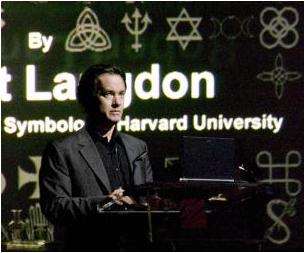
The next novel starring
Robert Langdon, Harvard author
of "the renowned collegiate
texbook Religious Iconology"
is said to be titled
The Solomon Key.
Related material–
The Harvard Crimson online:
| Fishburne To Receive Honors at Cultural Rhythms Acclaimed actor and humanitarian chosen as the Harvard Foundation's Artist of the Year By DORIS A. HERNANDEZ Friday, February 16, 2007 9:37 PM Tony and Emmy Award-winning actor Laurence Fishburne will take the stage later this month as the 2007 Artist of the Year during the 22nd annual Cultural Rhythms festival, the Harvard Foundation for Intercultural and Race Relations announced Friday afternoon. |

Fishburne
as Morpheus

"Metaphor for Morphean morphosis,
Dreams that wake, transform, and die,
Calm and lucid this psychosis,
Joyce's nightmare in Escher's eye….
Dabo claves regni caelorum. By silent shore
Ripples spread from castle rock. The metaphor
For metamorphosis no keys unlock."
— Steven H. Cullinane,
November 7, 1986,
"Endgame"
More on metamorphosis–
Cat's Yarn
(Log24, June 20, 2006):
"The end is where
we start from."



plus.maths.org
and
Garfield 2003-06-24
See also:
Zen Koan
and
Blue Dream.
Update of 5:24 PM
Feb. 18, 2007:
A Xanga footprint from France
this afternoon (3:47 PM EST)
indicates that someone there
may be interested in the above
poem's "claves regni caelorum."
The visitor from France viewed
"Windmills" (Nov. 15, 2005).
Material related to that entry
may be found in various places
at Log24.com. See particularly
"Shine On, Hermann Weyl," and
entries for Women's History
Month last year that include
"Christ at the Lapin Agile."
Saturday, September 16, 2006
Saturday September 16, 2006
Pandora's Box
Part I:
The Pandora Cross
— Rosalind Krauss in "Grids"

Part II:
The Opening
Remarks by the Pope on Sept. 12,
as reported by the Vatican:
Faith, Reason, and the University:
Memories and Reflections
For the result of
the Pope's remarks, see
a transcript of
yesterday's Google News
and the following
from BBC today:

Click to enlarge the screenshot.
Part III:
Hope
"In September [2005], she had a private audience with Pope Benedict XVI at Castel Gandolfo, his summer residence outside Rome. She had criticized John Paul II for making overtures to Muslims, and for not condemning terrorism heartily enough, but she has hopes for Joseph Ratzinger."
For further details, see yesterday's Log24.
Part IV:
The Sibyl's Song
— From The Magic Circle,
a spiritual narrative
by Katherine Neville
For more on "the long-mute voice
of the past," on "darkness beneath
the volcano," and on uncorking,
see Glory Season and Harrowing.
Related material from
Log24 on Dec. 2, 2005:
Benedict XVI, before he became Pope:

and a related
Christian symbol,

the Greek Cross
(adapted from
Ad Reinhardt).
Moral of the Pandora Cross:
"Nine is a very powerful Nordic number."
— Katherine Neville in The Magic Circle…
quoted in The Nine, a Log24 entry
for Hermann Weyl's birthday,
November 9, 2004.
Friday, September 15, 2006
Friday September 15, 2006

In memory of
journalist Oriana Fallaci,
who died last night:
"In September [2005], she had a private audience with Pope Benedict XVI at Castel Gandolfo, his summer residence outside Rome. She had criticized John Paul II for making overtures to Muslims, and for not condemning terrorism heartily enough, but she has hopes for Joseph Ratzinger. (The meeting was something of a scandal in Italy, since Fallaci has always said that she is an atheist; more recently, she has called herself a 'Christian atheist,' out of respect for Italy's Catholic tradition.) Last December, the Italian government presented her with a gold medal for 'cultural achievement.'"
was published in March.
For more on the "medal"
pictured above,
see Log24 entries of
September 13 and 14
and of D-Day 2006.
Update of 4 PM Sept. 15–
Click for further details:
"She has hopes
for Joseph Ratzinger…."
Sunday, June 4, 2006
Sunday June 4, 2006
and Words
for Baccalaureate
Day at Princeton

From Hermann Weyl’s
Symmetry,
Princeton University
Press, page 140

Adapted from the
cover of Alan Watts’s
The Spirit of Zen

Romani flag, courtesy of

myspace.com/RomArmando
Related material:
“The Scholar Gypsy”
in The Oxford Book
of English Prose, 1923,
edited by
Sir Arthur Quiller-Couch
This is available online:
From The Vanity of Dogmatizing,
by Joseph Glanvill
(London, printed by E.C. for
Henry Eversden at the Grey-Hound
in St.Pauls-Church-Yard, 1661)
Pages 195-201:
That one man should be able to bind the thoughts of another, and determine them to their particular objects; will be reckon’d in the first rank of Impossibles: Yet by the power of advanc’d Imagination it may very probably be effected; and story abounds with Instances. I’le trouble the Reader but with one; and the hands from which I had it, make me secure of the truth on’t. There was very lately a Lad in the University of Oxford, who being of very pregnant and ready parts, and yet wanting the encouragement of preferment; was by his poverty forc’d to leave his studies there, and to cast himself upon the wide world for a livelyhood. Now, his necessities growing dayly on him, and wanting the help of friends to relieve him; he was at last forced to joyn himself to a company of Vagabond Gypsies, whom occasionally he met with, and to follow their Trade for a maintenance. Among these extravagant people, and by the insinuating subtilty of his carriage, he quickly got so much of their love, and esteem; as that they discover’d to him their Mystery: in the practice of which, by the pregnancy of his wit and parts he soon grew so good a proficient, as to be able to out-do his Instructors. After he had been a pretty while exercis’d in the Trade; there chanc’d to ride by a couple of Scholars who had formerly bin of his acquaintance. The Scholars had quickly spyed out their old friend, among the Gypsies; and their amazement to see him among such society, had well-nigh discover’d him: but by a sign he prevented their owning him before that Crew: and taking one of them aside privately, desired him with his friend to go to an Inn, not far distant thence, promising there to come to them. They accordingly went thither, and he follows: after their first salutations, his friends enquire how he came to lead so odd a life as that was, and to joyn himself with such a cheating beggarly company. The Scholar-Gypsy having given them an account of the necessity, which drove him to that kind of life; told them, that the people he went with were not such Impostours as they were taken for, but that they had a traditional kind of learning among them, and could do wonders by the power of Imagination, and that himself had learnt much of their Art, and improved in further than themselves could. And to evince the truth of what he told them, he said, he’d remove into another room, leaving them to discourse together; and upon his return tell them the sum of what they had talked of: which accordingly he perform’d, giving them a full acount of what had pass’d between them in his absence. The Scholars being amaz’d at so unexpected a discovery, ernestly desir’d him to unriddle the mystery. In which he gave them satisfaction, by telling them, that what he did was by the power of Imagination, his Phancy binding theirs; and that himself had dictated to them the discourse, they held together, while he was from them: That there were warrantable wayes of heightening the Imagination to that pitch, as to bind anothers; and that when he had compass’d the whole secret, some parts of which he said he was yet ignorant of, he intended to give the world an account of what he had learned.
Now that this strange power of the Imagination is no Impossibility; the wonderful signatures in the Foetus caus’d by the Imagination of the Mother, is no contemptible Item. The sympathies of laughing & gaping together, are resolv’d into this Principle: and I see not why the phancy of one man may not determine the cogitation of another rightly qualified, as easily as his bodily motion. This influence seems to be no more unreasonable, then [sic] that of one string of a Lute upon another; when a stroak on it causeth a proportionable motion in the sympathizing confort, which is distant from it and not sensibly touched. Now if this notion be strictly verifiable; ’twill yeeld us a good account of how Angels inject thoughts into our minds, and know our cogitations: and here we may see the source of some kinds of fascination. If we are prejudic’d against the speculation, because we cannot conceive the manner of so strange an operation; we shall indeed receive no help from the common Philosophy: But yet the Hypothesis of a Mundane soul, lately reviv’d by that incomparable Platonist and Cartesian, Dr. H. More, will handsomely relieve us. Or if any would rather have a Mechanical account; I think it may probably be made out some such way as follow. Imagination is inward Sense. To Sense is required a motion of certain Filaments of the Brain; and consequently in Imagination there’s the like: they only differing in this, that the motion of the one proceeds immediately from external objects; but that of the other hath its immediate rise within us. Now then, when any part of the Brain is stringly agitated; that, which is next and most capable to receive the motive Impress, must in like manner be moved. Now we cannot conceive any thing more capable of motion, then the fluid matter, that’s interspers’d among all bodies, and contiguous to them. So then, the agitated parts of the Brain begetting a motion in the proxime Aether; it is propagated through the liquid medium, as we see the motion is which is caus’d by a stone thrown into the water. Now, when the thus moved matter meets with anything like that, from which it received its primary impress; it will proportionably move it, as it is in Musical strings tuned Unisons. And thus the motion being convey’d, from the Brain of one man to the Phancy of another; it is there receiv’d from the instrument of conveyance, the subtil matter; and the same kind of strings being moved, and much of whay after the same manner as in the first Imaginant; the Soul is awaken’d to the same apprehensions, as were they that caus’d them. I pretend not to any exactness or infallibility in this account, fore-seeing many scruples that must be removed to make it perfect: ‘Tis only a hint of the possibility of mechanically solving the Phaenomenon; though very likely it may require many other circumstances completely to make it out. But ’tis not my business here to follow it: I leave it therefore to receive accomplishment from maturer Inventions.
Monday, May 29, 2006
Monday May 29, 2006
Strange Bedfellows
Ted Berkman, author of books about the Israeli military, died at 92 on May 12, 2006.
Dennis Hevesi in today’s New York Times:
“In World War II he served as the Middle East chief of the Foreign Broadcast Intelligence Service, a predecessor of the Central Intelligence Agency. In 1946, as a radio correspondent for ABC, he provided an eyewitness account of the bombing of the King David Hotel in Jerusalem by Jewish terrorists.”
He also worked as a screenwriter (with his brother-in-law Raphael Blau) on the films “Girl of the Night” (1960), starring Anne Francis, and “Bedtime for Bonzo” (1951), starring Diana Lynn.
These are two of my all-time favorite actresses, and I am grateful to Berkman for providing them with roles. I am less grateful for his Zionist politics. Who he is in bed with now, God only knows.
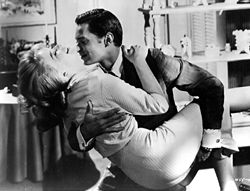
Anne Francis

Diana Lynn
Monday, February 13, 2006
Monday February 13, 2006
As yesterday’s Lincoln’s Birthday entry indicated, my own sympathies are not with the “created equal” crowd. Still, the Catholic Fascism of Franco admirer Andrew Cusack seems somewhat over-the-top. A more thoughtful approach to these matters may be found in a recommendation by Ross Douthat at The American Scene:
Read Eve Tushnet on the virtues of The Man in the High Castle.
Related material: Log24 on Nov. 14, Nov. 15, and Nov. 16, 2003.
Another item of interest from Eve:
“Transubstantiation [is equivalent but not equal to] art (deceptive accident hides truthful substance), as vs. Plato’s condemnation of the physical & the fictive? (Geo. Steiner)”
Related material:
(excerpt)
by Father Richard John Neuhaus,
First Things 115 (Aug.-Sept. 2001), 47-56:
“In Grammars of Creation, more than in his 1989 book Real Presences, Steiner acknowledges that his argument rests on inescapably Christian foundations. In fact, he has in the past sometimes written in a strongly anti–Christian vein, while the present book reflects the influence of, among others, Miri Rubin, whose Corpus Christi: The Eucharist in Late Medieval Culture is credited in a footnote. Steiner asserts that, after the Platonisms and Gnosticisms of late antiquity, it is the doctrines of incarnation and transubstantiation that mark ‘the disciplining of Western syntax and conceptualization’ in philosophy and art. ‘Every heading met with in a study of “creation,” every nuance of analytic and figural discourse,’ he says, derives from incarnation and transubstantiation, ‘concepts utterly alien to either Judaic or Hellenic perspectives– though they did, in a sense, arise from the collisions and commerce between both.’….
The incarnation of God in the Son, the transubstantiation of bread and wine into his body and blood, are ‘a mysterium, an articulated, subtly innervated attempt to reason the irrational at the very highest levels of intellectual pressure.’ ‘Uniquely, perhaps, the hammering out of the teaching of the eucharist compels Western thought to relate the depth of the unconscious and of pre-history with speculative abstractions at the boundaries of logic and of linguistic philosophy.’ Later, the ‘perhaps’ in that claim seems to have disappeared:
At every significant point, Western philosophies of art and Western poetics draw their secular idiom from the substratum of Christological debate. Like no other event in our mental history, the postulate of God’s kenosis through Jesus and of the never-ending availability of the Savior in the wafer and wine of the eucharist, conditions not only the development of Western art and rhetoric itself, but at a much deeper level, that of our understanding and reception of the truth of art– a truth antithetical to the condemnation of the fictive in Plato.
This truth reaches its unrepeated perfection in Dante, says Steiner. In Dante, ‘It rounds in glory the investigation of creativity and creation, of divine authorship and human poesis, of the concentric spheres of the aesthetic, the philosophical, and the theological. Now truth and fiction are made one, now imagination is prayer, and Plato’s exile of the poets refuted.’ In the fashionable critical theories of our day, we witness ‘endeavors of the aesthetic to flee from incarnation.’ ‘It is the old heresies which revive in the models of absence, of negation or erasure, of the deferral of meaning in late–twentieth–century deconstruction. The counter-semantics of the deconstructionist, his refusal to ascribe a stable significance to the sign, are moves familiar to [an earlier] negative theology.’ Heidegger’s poetics of ‘pure immanence’ are but one more attempt ‘to liberate our experience of sense and of form from the grip of the theophanic.’ But, Steiner suggests, attempted flights from the reality of Corpus Christi will not carry the day. ‘Two millennia are only a brief moment.’
Thursday, April 7, 2005
Thursday April 7, 2005
In the Details
Wallace Stevens,
An Ordinary Evening in New Haven:
XXII
Professor Eucalyptus said, "The search
For reality is as momentous as
The search for God." It is the philosopher's search
For an interior made exterior
And the poet's search for the same exterior made
Interior….
… Likewise to say of the evening star,
The most ancient light in the most ancient sky,
That it is wholly an inner light, that it shines
From the sleepy bosom of the real, re-creates,
Searches a possible for its possibleness.
Julie Taymor, "Skewed Mirrors" interview:
"… they were performing for God. Now God can mean whatever you want it to mean. But for me, I understood it so totally. The detail….
They did it from the inside to the outside. And from the outside to the in. And that profoundly moved me then. It was…it was the most important thing that I ever experienced."
The above may be of interest to students
of iconology — what Dan Brown in
The Da Vinci Code calls "symbology" —
and of redheads.
The artist of Details,
"Brenda Starr" creator
Dale Messick, died on Tuesday,
April 5, 2005, at 98.
For further details on
April 5, see
Art History:
The Pope of Hope

Tuesday, April 5, 2005
Tuesday April 5, 2005
The Pope of Hope

At the Vatican on
Shakespeare's Birthday
Oct. 4, 2002)
See also the iconology —
what Dan Brown in
The Da Vinci Code
calls "symbology" —
of Pandora's Box
at Log24.net,
March 10, 2005:

each containing the key to the other."
"Karol Wojtyla had looked into
the heart of darkness–
and at the heart of darkness
discovered reason
for an indomitable hope.
He lived on the far side of
the greatest catastrophe
in human history,
the death of the Son of God,
and knew that evil
did not have the last word.
This is the key…."
— Richard John Neuhaus,
April 4, 2005

Finnegans Wake, p. 293,
"the lazily eye of his lapis"

at the center of the breaking and
redefining of the Classical system."

Skewed Mirrors,
Sept. 14, 2003
"Evil did not have the last word."
— Richard John Neuhaus, April 4, 2005
| Lps. The keys to. Given! A way a lone a last a loved a long the PARIS, |
"There is never any ending to Paris."
— Ernest Hemingway
For the first word, see Louis Armand on
Lethe, erinnerung, and riverrun.
See also the following passage,
linked to on the Easter Vigil, 2005:
a spring,
And by the side thereof standing
a white cypress.
To this spring approach not near.
But you shall find another,
from the lake of Memory
Cold water flowing forth, and there are
guardians before it.
Say, "I am a child of Earth and starry Heaven;
But my race is of Heaven alone.
This you know yourselves.
But I am parched with thirst and I perish.
Give me quickly
The cold water flowing forth
from the lake of Memory."
Tuesday, January 4, 2005
Tuesday January 4, 2005
“Mr. Denker was of the romantic school
of chess – always looking to attack.”

Related material:
From Endgame:
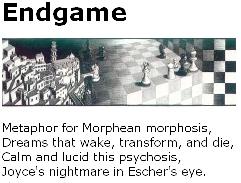
Black the knight upon that ocean,
Bright the sun upon the king.
Dark the queen that stands beside him,
White his castle, threatening.
In the shadows’ see a bishop
Guards his queen of love and hate.
Another move, the game will be up;
Take the queen, her knight will mate.
The knight said “Move, be done. It’s over.”
“Love and resign,” the bishop cried.
“When it’s done you’ll stand forever
By the darkest beauty’s side.”
From Log24.net, Feb. 18, 2003:

Kali, a goddess sometimes depicted
as a dancing girl; Kali is related to kAla,
time, according to one website, as
“the force which governs and stops time.”
See also the novel The Fermata,
by Nicholson Baker.

From an entry of Sunday, Jan. 2,
the day Denker died:
“Time had been canceled.”
— Stephen King, The Shining
From Truth and Style, a tribute
to the late Amy Spindler, style editor
of the New York Times Magazine:
“I don’t believe in truth. I believe in style.”
— Hugh Grant in Vogue magazine, July 1995
From a related page,
The Crimson Passion:
“He takes us to the central activity
of mathematics—which is imagining….”
— Harvard Magazine on
Harvard mathematician
and author Barry Mazur.
For related material on Mazur, see
“The teenagers aren’t all bad.
I love ’em if nobody else does.
There ain’t nothing wrong
with young people.
Jus’ quit lyin’ to ’em.”
Friday, April 9, 2004
Friday April 9, 2004
Temptation

Kylie sings
Locomotion.
In memory of Victor Argo,
who died Tuesday, April 6, 2004.
Today's New York Times
says Mr. Argo was cast
"somewhat against type"
by Martin Scorsese as

The Apostle Peter in
"The Last Temptation of Christ."
Sunday, November 30, 2003
Sunday November 30, 2003
The Proof and the Lie
A mathematical lie has been circulating on the Internet.
It concerns the background of Wiles’s recent work on mathematics related to Fermat’s last theorem, which involves the earlier work of a mathematician named Taniyama.
This lie states that at the time of a conjecture by Taniyama in 1955, there was no known relationship between the two areas of mathematics known as “elliptic curves” and “modular forms.”
The lie, due to Harvard mathematician Barry Mazur, was broadcast in a TV program, “The Proof,” in October 1997 and repeated in a book based on the program and in a Scientific American article, “Fermat’s Last Stand,” by Simon Singh and Kenneth Ribet, in November 1997.
“… elliptic curves and modular forms… are from opposite ends of the mathematical spectrum, and had previously been studied in isolation.”
— Site on Simon Singh’s 1997 book Fermat’s Last Theorem
“JOHN CONWAY: What the Taniyama-Shimura conjecture says, it says that every rational elliptic curve is modular, and that’s so hard to explain.
BARRY MAZUR: So, let me explain. Over here, you have the elliptic world, the elliptic curves, these doughnuts. And over here, you have the modular world, modular forms with their many, many symmetries. The Shimura-Taniyama conjecture makes a bridge between these two worlds. These worlds live on different planets. It’s a bridge. It’s more than a bridge; it’s really a dictionary, a dictionary where questions, intuitions, insights, theorems in the one world get translated to questions, intuitions in the other world.
KEN RIBET: I think that when Shimura and Taniyama first started talking about the relationship between elliptic curves and modular forms, people were very incredulous….”
— Transcript of NOVA program, “The Proof,” October 1997
The lie spread to other popular accounts, such as the column of Ivars Peterson published by the Mathematical Association of America:
“Elliptic curves and modular forms are mathematically so different that mathematicians initially couldn’t believe that the two are related.”
— Ivars Peterson, “Curving Beyond Fermat,” November 1999
The lie has now contaminated university mathematics courses, as well as popular accounts:
“Elliptic curves and modular forms are completely separate topics in mathematics, and they had never before been studied together.”
— Site on Fermat’s last theorem by undergraduate K. V. Binns
Authors like Singh who wrote about Wiles’s work despite their ignorance of higher mathematics should have consulted the excellent website of Charles Daney on Fermat’s last theorem.
A 1996 page in Daney’s site shows that Mazur, Ribet, Singh, and Peterson were wrong about the history of the known relationships between elliptic curves and modular forms. Singh and Peterson knew no better, but there is no excuse for Mazur and Ribet.
Here is what Daney says:
“Returning to the j-invariant, it is the 1:1 map betweem isomorphism classes of elliptic curves and C*. But by the above it can also be viewed as a 1:1 map j:H/r -> C. j is therefore an example of what is called a modular function. We’ll see a lot more of modular functions and the modular group. These facts, which have been known for a long time, are the first hints of the deep relationship between elliptic curves and modular functions.”
“Copyright © 1996 by Charles Daney,
All Rights Reserved.
Last updated: March 28, 1996″
Update of Dec. 2, 2003
For the relationship between modular functions and modular forms, see (for instance) Modular Form in Wikipedia.
Some other relevant quotations:
From J. S. Milne, Modular Functions and Modular Forms:
“The definition of modular form may seem strange, but we have seen that such functions arise naturally in the [nineteenth-century] theory of elliptic functions.”
The next quote, also in a nineteenth-century context, relates elliptic functions to elliptic curves.
From Elliptic Functions, a course syllabus:
“Elliptic functions parametrize elliptic curves.”
Putting the quotes together, we have yet another description of the close relationship, well known in the nineteenth century (long before Taniyama’s 1955 conjecture), between elliptic curves and modular forms.
Another quote from Milne, to summarize:
“From this [a discussion of nineteenth-century mathematics], one sees that arithmetic facts about elliptic curves correspond to arithmetic facts about special values of modular functions and modular forms.”
Serge Lang apparently agrees:
“Elliptic functions parametrize elliptic curves, and the intermingling of the analytic and algebraic-arithmetic theory has been at the center of mathematics since the early part of the nineteenth century.”
— Editorial description of Lang’s Elliptic Functions (second edition, 1987)
Update of Dec. 3, 2003
“The theory of modular functions and modular forms, defined on the upper half-plane H and subject to appropriate tranformation laws with respect to the group Gamma = SL(2, Z) of fractional linear transformations, is closely related to the theory of elliptic curves, because the family of all isomorphism classes of elliptic curves over C can be parametrized by the quotient Gamma\H. This is an important, although formal, relation that assures that this and related quotients have a natural structure as algebraic curves X over Q. The relation between these curves and elliptic curves predicted by the Taniyama-Weil conjecture is, on the other hand, far from formal.”
— Robert P. Langlands, review of Elliptic Curves, by Anthony W. Knapp. (The review appeared in Bulletin of the American Mathematical Society, January 1994.)
Sunday, July 13, 2003
Sunday July 13, 2003
ART WARS, 5:09
The Word in the Desert
For Harrison Ford in the desert.
(See previous entry.)
Words strain,
Crack and sometimes break,
under the burden,
Under the tension, slip, slide, perish,
Will not stay still. Shrieking voices
Scolding, mocking, or merely chattering,
Always assail them.
The Word in the desert
Is most attacked by voices of temptation,
The crying shadow in the funeral dance,
The loud lament of
the disconsolate chimera.— T. S. Eliot, Four Quartets
The link to the word "devilish" in the last entry leads to one of my previous journal entries, "A Mass for Lucero," that deals with the devilishness of postmodern philosophy. To hammer this point home, here is an attack on college English departments that begins as follows:
"William Faulkner's Snopes trilogy, which recounts the generation-long rise of the drily loathsome Flem Snopes from clerk in a country store to bank president in Jefferson, Mississippi, teems with analogies to what has happened to English departments over the past thirty years."
For more, see
The Word in the Desert,
by Glenn C. Arbery.
See also the link on the word "contemptible," applied to Jacques Derrida, in my Logos and Logic page.
This leads to an National Review essay on Derrida,
The Philosopher as King,
by Mark Goldblatt.
A reader's comment on my previous entry suggests the film "Scotland, PA" as viewing related to the Derrida/Macbeth link there.
I prefer the following notice of a 7-11 death, that of a powerful art museum curator who would have been well cast as Lady Macbeth:
|
Die Fahne Hoch, |
|
From the Whitney Museum site:
"Max Anderson: When artist Frank Stella first showed this painting at The Museum of Modern Art in 1959, people were baffled by its austerity. Stella responded, 'What you see is what you see. Painting to me is a brush in a bucket and you put it on a surface. There is no other reality for me than that.' He wanted to create work that was methodical, intellectual, and passionless. To some, it seemed to be nothing more than a repudiation of everything that had come before—a rational system devoid of pleasure and personality. But other viewers saw that the black paintings generated an aura of mystery and solemnity.
The title of this work, Die Fahne Hoch, literally means 'The banner raised.' It comes from the marching anthem of the Nazi youth organization. Stella pointed out that the proportions of this canvas are much the same as the large flags displayed by the Nazis.
But the content of the work makes no reference to anything outside of the painting itself. The pattern was deduced from the shape of the canvas—the width of the black bands is determined by the width of the stretcher bars. The white lines that separate the broad bands of black are created by the narrow areas of unpainted canvas. Stella's black paintings greatly influenced the development of Minimalism in the 1960s."
From Play It As It Lays:
She took his hand and held it. "Why are you here."
"Because you and I, we know something. Because we've been out there where nothing is. Because I wanted—you know why."
"Lie down here," she said after a while. "Just go to sleep."
When he lay down beside her the Seconal capsules rolled on the sheet. In the bar across the road somebody punched King of the Road on the jukebox again, and there was an argument outside, and the sound of a bottle breaking. Maria held onto BZ's hand.
"Listen to that," he said. "Try to think about having enough left to break a bottle over it."
"It would be very pretty," Maria said. "Go to sleep."
I smoke old stogies I have found…
Cigar Aficionado on artist Frank Stella:
" 'Frank actually makes the moment. He captures it and helps to define it.'
This was certainly true of Stella's 1958 New York debut. Fresh out of Princeton, he came to New York and rented a former jeweler's shop on Eldridge Street on the Lower East Side. He began using ordinary house paint to paint symmetrical black stripes on canvas. Called the Black Paintings, they are credited with paving the way for the minimal art movement of the 1960s. By the fall of 1959, Dorothy Miller of The Museum of Modern Art had chosen four of the austere pictures for inclusion in a show called Sixteen Americans."
For an even more austere picture, see

For more on art, Derrida, and devilishness, see Deborah Solomon's essay in the New York Times Magazine of Sunday, June 27, 1999:
"Blame Derrida and
his fellow French theorists…."
See, too, my site
Art Wars: Geometry as Conceptual Art.
For those who prefer a more traditional meditation, I recommend
("Behold the Wood of the Cross")
For more on the word "road" in the desert, see my "Dead Poet" entry of Epiphany 2003 (Tao means road) as well as the following scholarly bibliography of road-related cultural artifacts (a surprising number of which involve Harrison Ford):
Sunday, June 29, 2003
Sunday June 29, 2003
Every Boy Has a Daddy
Today is the Feast of Saint Peter.
The most timely quote I know of for today’s religious observances is from Oh What a Web They Weave, by F. John Loughnan:
This was written as part of an attack on the father of a Latin-Mass Catholic who authored the website Ecclesia Militans, which has the logo
Note the resemblance to the Iron Cross.
Soldier of Fortune magazine, April 2002, contains a brief discussion of the German motto “Gott mit uns” that is relevant to the concept of The Church Militant.
Soldier of Fortune,
April 2002
The actor on the cover, Mel Gibson, also serves to illustrate our meditation for today, “Every boy has a daddy.” See Christopher Noxon’s article in the New York Times Magazine of March 9, 2003:
Noxon attacks Gibson’s father Hutton — like his son Mel, a Latin-Mass Catholic, and author of
A related “Every boy has a daddy” attack appears in the June 2003 issue of Playboy magazine. An entertaining excerpt from this attack on Joseph P. Kennedy, father of JFK, may be found at Orwell Today.
Finally, let us meditate on the ultimate “Every boy has a daddy” attack — by novelist Robert Stone on the alleged father of Jesus of Nazareth:
|
Excerpt from From the mosques, from the alleys, from the road: “Allahu Akbar!” …. Then a voice shouted: “Itbah al-Yahud!” …. Kill the Jew! …. “Itbah al-Yahud!” the crowd screamed…. Then Lucas saw the things they had taken up: trowels and mallets and scythes, some dripping blood. Everyone was screaming, calling on God. On God, Lucas thought. He was terrified of falling, of being crushed by the angry swarm that was whirling around him. He wanted to pray. “O Lord,” he heard himself say. The utterance filled him with loathing, that he was calling on God, on that Great Fucking Thing, the Lord of Sacrifices, the setter of riddles. Out of the eater comes forth meat. The poser of parables and shibboleths. The foreskin collector, connoisseur of humiliations, slayer by proxy of his thousands, his tens of thousands. Not peace but a sword. The Lunatic Spirit of the Near East, the crucified and crucifier, the enemy of all His own creation. Their God-Damned God. |
The New York Times Magazine article mentioned above was prompted, in part, by Mel Gibson’s current movie production, “The Passion,” about the final 12 hours in the (first, or possibly second) life of Jesus. If I were producing a Passion play, as Peter I would certainly cast Stone.
See also the 11 PM sequel to the above.
Friday, February 21, 2003
Friday February 21, 2003
ART WARS:
All About Lilith
|
|
|
Sam Peckinpah (Feb. 21, 1925)
The New Yorker Magazine (Feb. 21, 1925)
Alan Rickman, 57
Kelsey Grammer, 48
Mary Chapin Carpenter, 45
Jennifer Love Hewitt, 24
Charlotte Church, 17
This list suggests that in an ideal future life Sam Peckinpah would direct, and The New Yorker review, a prequel to “All About Eve.”
Casting would be as follows:
Mary Chapin Carpenter as Margo Channing
(originally, Bette Davis)
Charlotte Church as Lilith, sister of Eve Harrington
(originally, Anne Baxter)
Jennifer Love Hewitt as Claudia Casswell
(originally, Marilyn Monroe)
Alan Rickman as Bill Sampson
(originally, Gary Merrill)
Kelsey Grammer as Addison DeWitt
(originally, George Sanders).
Since today is also the anniversary, according to Tom’s Book of Days, of Schultes’s identification of teonanacatl in 1939, the following classic painting, “ Caterpillar’s Mushroom,” by Brian Froud, might be adapted for a poster for our heavenly production*, to be titled, in accordance with celestial fairness doctrines,

* A footnote in memory of publicist/producer Jack Brodsky (“Romancing the Stone,” etc.), who died on Tuesday, Feb. 18, 2003 — See the website Eight is a Gate for the mystical significance of the number “78” in Judaism. The New Yorker and Sam Peckinpah were born 78 years ago today.
Friday, January 10, 2003
Friday January 10, 2003
Story
"How much story do you want?"
— George Balanchine
While researching yesterday's entry on Balanchine, Apollo, and the nine Muses, I came across this architect's remarks, partially quoted yesterday and continued here:
"The icon that I use for this element is the nine-fold square…. This is the garden of Apollo, the field of Reason…. This is the Temple of Solomon, as inscribed, for example, by a nine-fold compartmentation to provide the ground plan of Yale, as described to me by Professor Hersey."
Checking this out yesterday, I came across the following at a Yale University Art Gallery site:
"This exhibition of nine boldly colored, asymmetrically designed quilts selected from a private collection will be displayed in the Matrix Gallery….
With the guidance of Professor Maude Southwell Wahlman, author of 'Signs and Symbols: African Images in African American Quilts,' the collector has explored and gathered examples…."
Exploring and gathering examples myself today, I received a book in the mail — W. M. Spackman's On the Decay of Humanism (Rutgers University Press, 1967) — and picked up a second-hand book at a sale — Barbara Michaels's Stitches in Time (Harper Collins Publishers, 1995).
The Spackman book includes the following poem at the end:
In sandarac etui for sepulchre
lies the cered body of a poisoned queen;
and in her mouth and hair, and at her feet,
and in the grey folds of her winding-sheet,
there sifts a dreamy powder, smooth and green,
the magic of an idle sorcerer,
an ancient spell, cast when the shroud was spun.
In death her hands clasp amourously a bowl
that still contains the fragments of her soul,
a tale of Beauty sought, and Beauty won,
his false lips kissed, and Beauty dead for her.
— Alexander B. Griswold, Princeton '28, in the
Nassau Literary Magazine of December 1925
From a synopsis of Michaels's Stitches in Time:
"Michaels follows Rachel, a graduate student studying women's crafts–weaving, spinning, quilting, embroidery–and the superstitions connected with them. Linking all important rites of passage to the garments created as markers of these occasions leads Rachel to her theory: in societies in which magic was practiced, the garment was meant to protect its wearer. She gains evidence that her theory is valid when an evil antique bridal quilt enters her life."
Although Stitches in Time is about a quilt — stitched, not spun — Griswold's line
"an ancient spell, cast when the shroud was spun"
is very closely related to the evil spell in Michaels's book.
The above events display a certain synchronicity that Wallace Stevens might appreciate, especially in light of the following remark in a review of Stitches in Time:
"…the premise is too outlandish for even the suspension of disbelief…." (Publishers Weekly, 4/24/95)
Stevens might reply,
The very man despising honest quilts
Lies quilted to his poll in his despite.— "The Comedian as the Letter C," Part V
Finally, those who prefer stories to the more formal qualities of pure dance (ballet) pure mathematics (see previous entry), pure (instrumental) music, and pure (abstract, as in quilt designs) art, can consult the oeuvre of Jodie Foster — as in my
Pearl Harbor Day entry on Buddhism.
An art historian named Griswold — perhaps that very same Griswold quoted above — might have a thing or two to say to Jodie on her recent film "Anna and the King." In the April, 1957, issue of The Journal of the Siam Society, Alexander B. Griswold takes issue with Broadway's and Hollywood's "grotesque caricature" of Siamese society, and ultimately with Anna herself:
"The real fault lies in the two books they ultimately spring from — The English Governess at the Court of Siam and The Romance of the Harem — both written by Mrs. Anna Leonowens.''
See also The Diamond 16 Puzzle for some quilt designs.
Wednesday, January 8, 2003
Wednesday January 8, 2003
In the Labyrinth of Memory
Taking a cue from Danny in the labyrinth of Kubrick's film "The Shining," today I retraced my steps.
My Jan. 6 entry, "Dead Poet in the City of Angels," links to a set of five December 21, 2002, entries. In the last of these, "Irish Lament," is a link to a site appropriate for Maud Gonne's birthday — a discussion of Yeats's "Among School Children."
Those who recall a young woman named Patricia Collinge (Radcliffe '64) might agree that her image is aptly described by Yeats:
Hollow of cheek as though it drank the wind
And took a mess of shadows for its meat
This meditation leads in turn to a Sept. 20, 2002, entry, "Music for Patricias," and a tune familiar to James Joyce, "Finnegan's Wake," the lyrics of which lead back to images in my entries of Dec. 20, 2002, "Last-Minute Shopping," and of Dec. 28, 2002, "Solace from Hell's Kitchen." The latter entry is in memory of George Roy Hill, director of "The Sting," who died Dec. 27, 2002.
The Dec. 28 image from "The Sting" leads us back to more recent events — in particular, to the death of a cinematographer who won an Oscar for picturing Newman and Redford in another film — Conrad L. Hall, who died Saturday, Jan. 4, 2003.
For a 3-minute documentary on Hall's career, click here.
Hall won Oscars for "Butch Cassidy and the Sundance Kid" and "American Beauty," and may win a posthumous Oscar for "Road to Perdition," last year's Irish-American mob saga:
"Tom Hanks plays Angel of Death Michael Sullivan. An orphan 'adopted' by crime boss John Rooney (Paul Newman), Sullivan worships Rooney above his own family. Rooney gave Sullivan a home when he had none. Rooney is the father Sullivan never knew. Too bad Rooney is the
Rock Island
branch of Capone's mob."
In keeping with this Irish connection, here is a set of images.
|
American Beauty |
|
|
A Game of Chess |
I need a photo-opportunity. I want a shot at redemption. Don't want to end up a cartoon In a cartoon graveyard. — Paul Simon |
"Like a chess player, he knows that to win a tournament, it is sometimes wise to offer a draw in a game even when you think you can win it."
— Roger Ebert on Robert Duvall's character in "A Civil Action"
Director Steven Zaillian will take part in a tribute to Conrad L. Hall at the Palm Springs International Film Festival awards ceremony on Jan 11. Hall was the cinematographer for Zaillian's films "A Civil Action" and "Searching for Bobby Fischer."
"A Civil Action" was cast by the Boston firm Collinge/Pickman Casting, named in part for that same Patricia Collinge ("hollow of cheek") mentioned above.
See also "Conrad Hall looks back and forward to a Work in Progress." ("Work in Progress" was for a time the title of Joyce's Finnegans Wake.)
What is the moral of all this remembrance?
An 8-page (paper) journal note I compiled on November 14, 1995 (feast day of St. Lawrence O'Toole, patron saint of Dublin, allegedly born in 1132) supplies an answer in the Catholic tradition that might have satisfied Joyce (to whom 1132 was a rather significant number):
How can you tell there's an Irishman present
at a cockfight?
He enters a duck.
How can you tell a Pole is present?
He bets on the duck.
How can you tell an Italian is present?
The duck wins.
|
Every picture tells a story. |
|
Friday, January 3, 2003
Friday January 3, 2003
The Shanghai Gesture:
An Exercise in Synchronicity
“A corpse will be transported by express!”
— Under the Volcano, by Malcolm Lowry (1947)
|
|
|
For Dietrich, see the reference below;
For Minogue, see my entry
“That Old Devil Moon”
of January 1st, 2003.
|
From the Turner Classic Movies website: PLAYING ON TCM: Shanghai Express (1932) A beautiful temptress re-kindles an old romance while trying to escape her past during a tension-packed train journey. [Set in 1931] BW-82m |
From The New Yorker magazine,
received in the mail this afternoon:
|
Shanghai Moon “…a new play… set in Shanghai in 1931…. Previews begin Jan. 3.” |
Given the above, a believer in synchronicity
under the volcano
will naturally search for a suitable corpse…
and voilà:
|
Friday, Jan. 3, 2003. 05:50 PM Syndicated astrologist LOS ANGELES (AP) — Sydney Omarr, the astrologer to the stars who came to write horoscopes that appear in more than 200 North American newspapers, has died. He was 76. Omarr, who was blinded and paralysed from the neck down by multiple sclerosis, died Thursday [Jan. 2, 2003] in hospital in Santa Monica of complications from a heart attack, the Los Angeles Times reported. His ex-wife, assistants and several close friends were by his side. Born Sidney Kimmelman in Philadelphia, Omarr decided to change his name at age 15 after watching a movie called The Shanghai Gesture, starring Victor Mature as a character named Omar. He changed the spelling of his first name and adopted Omar as his last name, but added a second “r,” in accordance with certain numerological formulas. |
“It has a ghastly familiarity,
like a half-forgotten dream.”
— Poppy (Gene Tierney) in
“The Shanghai Gesture.”
“It’s a gesture, dear, not a recipe.”
— Peggy (Vanessa Redgrave) in
“Prick Up Your Ears“
Thursday, November 7, 2002
Thursday November 7, 2002
16 Years Ago Today:
Endgame

Metaphor for Morphean morphosis,
Dreams that wake, transform, and die,
Calm and lucid this psychosis,
Joyce’s nightmare in Escher’s eye.
At the end there is a city
With cathedral bright and sane
Facing inward from the pity
On the endgame’s wavy plane.
Black the knight upon that ocean,
Bright the sun upon the king.
Dark the queen that stands beside him,
White his castle, threatening.
In the shadows’ see a bishop
Guards his queen of love and hate.
Another move, the game will be up;
Take the queen, her knight will mate.
The knight said “Move, be done. It’s over.”
“Love and resign,” the bishop cried.
“When it’s done you’ll stand forever
By the darkest beauty’s side.”
Dabo claves regni caelorum. By silent shore
Ripples spread from castle rock. The metaphor
For metamorphosis no keys unlock.
— Steven H. Cullinane, November 7, 1986
Accompaniment from
“The Thomas Crown Affair”:
Michel Legrand, “Les Moulins de Mon Coeur”
Lyrics by Eddy Marnay:
Comme une pierre que l’on jette
Dans l’eau vive d’un ruisseau
Et qui laisse derrière elle
Des milliers de ronds dans l’eau….
Friday, October 11, 2002
Friday October 11, 2002
The Fourth Man:
In Lieu of Rosebud, Part III

Carlos Castañeda, who led
El Nuevo Herald, dies at 70
Carlos Castañeda, the publisher emeritus of El Nuevo Herald whose passionate belief in a free press helped guide several newspapers across Latin America, died Thursday morning in Lisbon, Portugal. He was 70.
|
From a site titled
|
The Active Side of Infinityby Carlos CastañedaCarlos’ last book before his untimely death. In his desperate search for meaning, Carlos recapitulates Don Juan’s teachings in perhaps his best effort. The nature of silence, and the statement that the egoic mind is a foreign implant, give deep resonance to these final teachings of Don Juan. |
Arthur Koestler’s somewhat more respectable mystical thoughts about infinity may be found here. Related material: my September 5 entry, Arrow in the Blue.
Added ca. 10 to 11:40 p.m. October 11, 2002:
A review of Castaneda seems in order… the bad Carlos, not the good Carlos. (The bad Carlos being, of course, the bullshit artist who apparently died in 1998, and the good Carlos the publisher who died yesterday.)
From the LiveJournal site of fermina —
Today’s Public Service Message:
| Hi. You’re going to die. |
My comment:
From a review of Carlos Castaneda’s last book, The Active Side of Infinity:
“We wind up learning something more of Castaneda but not much at all about the active side of infinity, which is mystically translated as ‘intent.’ It appears that we ought to live with intent, never forgetting that we will die, regardless. Death (and the knowledge of it) should thus inform all of our actions and relationships, providing a perspective and enforcing our humility. This is hardly an original idea, and it can’t justify wading through Castaneda’s welter of self-indulgence, which might translate better to a bumper-sticker adage.”
Hmm… What adage might that be?
As for the good Carlos, see “In Lieu of Rosebud, Part II,” below… As was said of Saint Francis Borgia, whose feast is celebrated on the day good Carlos died, he
rendered glorious a name which, but for him, would have remained a source of humiliation.

Tuesday, October 8, 2002
Tuesday October 8, 2002
| Starflight Theme
On Graham Greene’s novel “Greene, always the master of economy, never wrote a tighter or more beautifully focused novel.” |
|
“The main character is Maurice Castle, the head of the Africa station for a branch of British intelligence…. [the] writing is sparse and neat rather than languid or flowery….”
— Kevin Holtsberry
From Chapter I:
“Castle could see that telling the truth this time had been an error of judgement, yet, except on really important occasions, he always preferred the truth. The truth can be double-checked.”
On fiction and truth:
Here is a short story that is
tight, focused, sparse, and neat.
The story is also true.
 |
This problem embodies the “starflight” theme;
for details, see Tim Krabbé’s
Open Chess Diary, entry 9.
As the example of Nabokov shows, a taste for truth (as in chess or geometry) may accompany a taste for fiction. This applies also to Krabbé, as shown by the following reviews of his novel The Cave:
New York Times
“Krabbe’s carefully constructed narrative has a geometry so precise that the patterns buried under the surface emerge only in the final pages.”
Library Journal
“A diamond of a book- perfectly proportioned, multifaceted, and containing not one wasted word”
Sunday, September 1, 2002
Sunday September 1, 2002
Backbeat in Heaven
The great musician Lionel Hampton died at about 6:15 a.m. EDT Saturday, August 31, 2002, in New York City’s Mount Sinai Medical Center.
Quincy Jones said, “Heaven will definitely be feeling some backbeat now.” (AP story)
Hampton himself said, “I learned all that in the sanctified church.” (N.Y. Times story)
Can we hear an AMEN?
Yes, we heard an amen… Live from Lincoln Center on PBS from about 10 p.m. to 11 p.m. EDT tonight (Sunday, September 1, 2002), in a live broadcast of the final performance of the musical “Contact.”
 |
Theology was made visible by Colleen Dunn, who appeared as Grace (the girl in the yellow dress). Christ himself was present in the form of a CD of “Do You Wanna Dance?” held aloft by a priest (the after-hours club bartender). |
The evening ended with the redemption by Grace of a sinner (a maker of TV commercials) and with (as Quincy Jones noted) a strong new backbeat in heaven.













